Sweden is a country with great racers who have gone through the biggest categories of motorsport in the world.

The Scandinavian peoples seemingly have an inherent ability to get a car to go around corners.

Couples in traditional Swedish folk costumes parade at midsummer celebration.


Svenskarnas Dag Girls Choir. Svenskarnas Dag Swedish Heritage Day.
In the middle of the Swedish forests is the Anderstorp track. This makes me remember how fabulous Formula 1 used to be and realize how different its current manifestation is.

The blonde girl who acted as this years Lucia queen and rode through.

A Christmas 'Crown of candles'. Marking the annual Lucia Day festival of lights, 19-year-old Anne Marie Peterson of Stockholm, Sweden wears a crown of candles after being crowned Queen of Light by the Scandinavian-Canadian Club at Queen's Park.

The Lucia tradition is as integral to Swedish culture as midsummer and crayfish parties. Immensely atmospheric, this 400-year-old custom brings peaceful joy each year on 13 December – and it’s spreading across the world. Photo credit: OTW/imagebank.sweden.se
Back in 1978 when Sweden was on the peak with Björn Borg, Ingemar Stenmark, ABBA, Volvo Saab Turbo and a formula 1 GP race, those were the years.

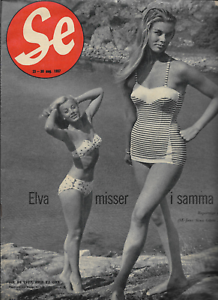

The F1 cars of that era look so cool with their huge rears and small fronts, looks like a road course dragster.
These were the days the race fans could get up close to the cars and drivers that is not possible these days.


Anita Ekberg.
When F1 was truly a tough man sport. The circuits were fast and dangerous, the cars were fast and dangerous and the men who drove them knew and accepted ALL of the consequences. Unlike today's modern sissified drivers with all the electronic controls and aids. The circuits have become Mickey Mouse... the cars are too safe there is no danger of fatality anymore.

Anderstorp, Scandinavia's only Formula 1 race track, is a long standing marker in Swedish racing history. This is where the greats of F1 battled in the glory days and where speed kings of Scandinavia were crowned for decades.

Inauguration of urban symbol in Anderstorp.
The circuit was completed in May 1968.
Swedish Formula 1 Grand Prix was run on the track a total of six times in the 70's between 1973-78.
The circuit is very popular among drivers for corners with famous names like Carousel and Hansen and combines a very long straight, about 1000 m long, with cambered sweeping high speed corners and tight hairpin turns. It demands a good setup of the car and precise lines from the driver to master. The tight final corner combination is always an invitation for last lap heroics, at Anderstorp your win is not certain until the very final meter.
The track has recently been renovated and refurbished and has once again hosted several international racing series, such as WTCC, ETCC, EURO-Boss and Superbike World Championships to name a few. All event activities are carried out on southern loop of the track, which is 2000 m long.

The track in 1973 and the chicane added between 1974 and 1978.
The layout of the track has never been changed since it was in Formula 1. It looks like the old fashioned way. A circuit from the good old days...
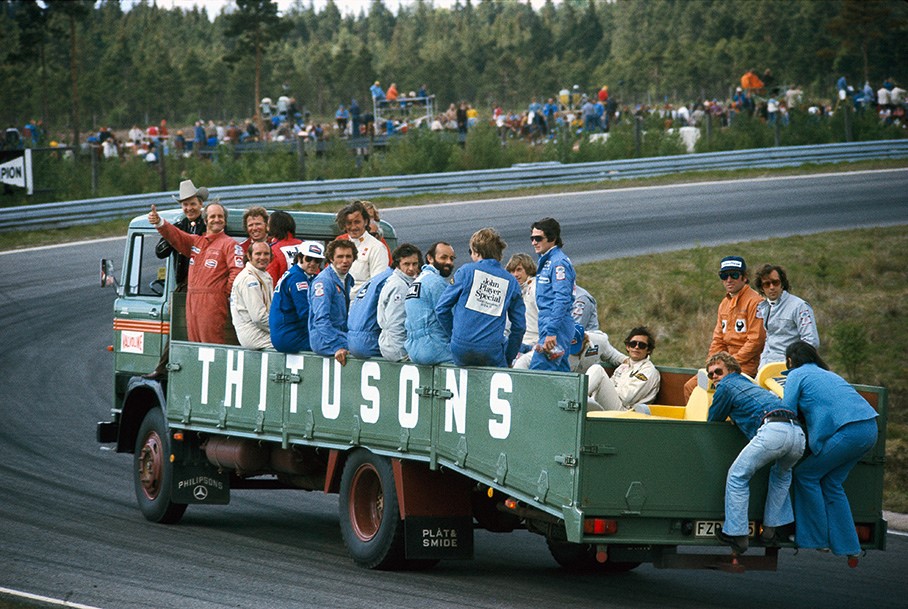
Drivers parade at Anderstorp in 1974. Photo by Rainer Schlegelmilch.
As a curious fact, when the track was used in F1, the original start line was at the little straight before the double hairpin, because the main straight they use now was too short.

Scandinavian Raceway – Anderstorp. 2009.01.04.
The training round that became the Formula 1 track.
It is nine o'clock on a late summer day in 1965. At Blad's café in Anderstorp, the three companions at Team Mosarp, Sven ”Smokey” Åsberg, Åke ”Rörkrökarn” Bengtsson and myself, Bertil Sanell, gathered for the daily morning coffee. But this time the topic of conversation is different from the usual ones on how to get a better spin on the cars and the next race. Sven had a while ago thrown out that we would build a short training and test round, to try trimming ideas on. 1.5 kilometers long would be enough, thought Sven, who also undertook to search for a suitable land area and calculate a little on what it would cost. The report would arrive this morning.
"It will be too expensive," Sven said. Åke laughed. A short pearly giggle, which always broke out when he was amused by something said. "I thought so," he said. I, who put every penny I could reach and beat in the competition, drew a sigh of relief. Sven munched the pastry, took a sip of coffee and said: "we will build a large track four km long… at Stötabomossen". Åke giggled again and I asked in horror: “will it be cheaper?” Sven, now with a freshly lit cigar pointing upwards to the roof - as always when he had something amazing to say - said from the corner of his mouth "no, but we will not pay, the industrialists in the village will do it".
And so it went. In 1966, construction began on the runway, which was completed well before the inauguration competition on June 16, 1968. And then together with the decoy that made the "industrialists" develop the stock exchange, an airfield section with a daily Stockholm connection. "In five years we will be driving Formula 1". But it was actually the case that a competition was held on the track before 16 June. SBF thought it was a bit adventurous to let the newly formed Anderstorp Racing Club start with such an advanced event as it was at the inauguration - an international sports car competition with world stars on the starting line. Thus, it was decided that the track and the club in May would first organize a "secret" competition to train the officials. At a press conference after the inauguration, this year's media bomb exploded. Sven Åsberg, now with the epithet "Smokey" attached to his person, declared without blinking; "in five years we will be driving Formula 1 here". The statement was followed first by a surprised silence and then a general gaping laughter.
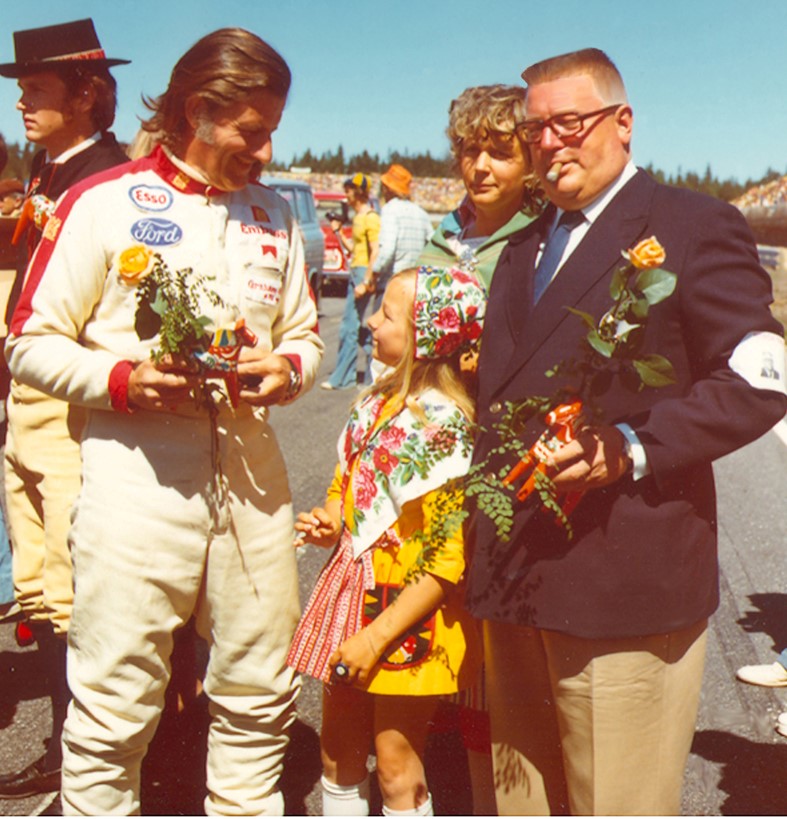
At the goal of dreams. Sven "Smokey" Åsberg is flower-flowered here with the drivers' representative, Graham Hill. In a few minutes, "Smokey" will wave the starting flag for Sweden's F1 Grand Prix in 1973. 52,000 spectators watched the competition. Photo: Alf-Erik Axelsson.
But five years later, on June 17, 1973, the start of Sweden's first Formula 1 Grand Prix happened for real. It was not the first World Cup event on the track. Already two years earlier, the world's motorcycle elite was on site for a competition of their World Cup series. The Mc-VM was then on the program until 1993. A local authority then decided, on noise and rules levels, that made competitions at this level was impossible. In the Formula 1 WC, six races were arranged until 1978. One race was also planned for 1979 but had to be canceled. Mainly due to Ronnie Peterson's tragic death at Monza, which in terms of sponsorship more or less "floored" Swedish motorsport for several years to come. Until empty. In 2009, 54 international championships with FIA and FIM status were held at Scandinavian Raceway in Anderstorp.
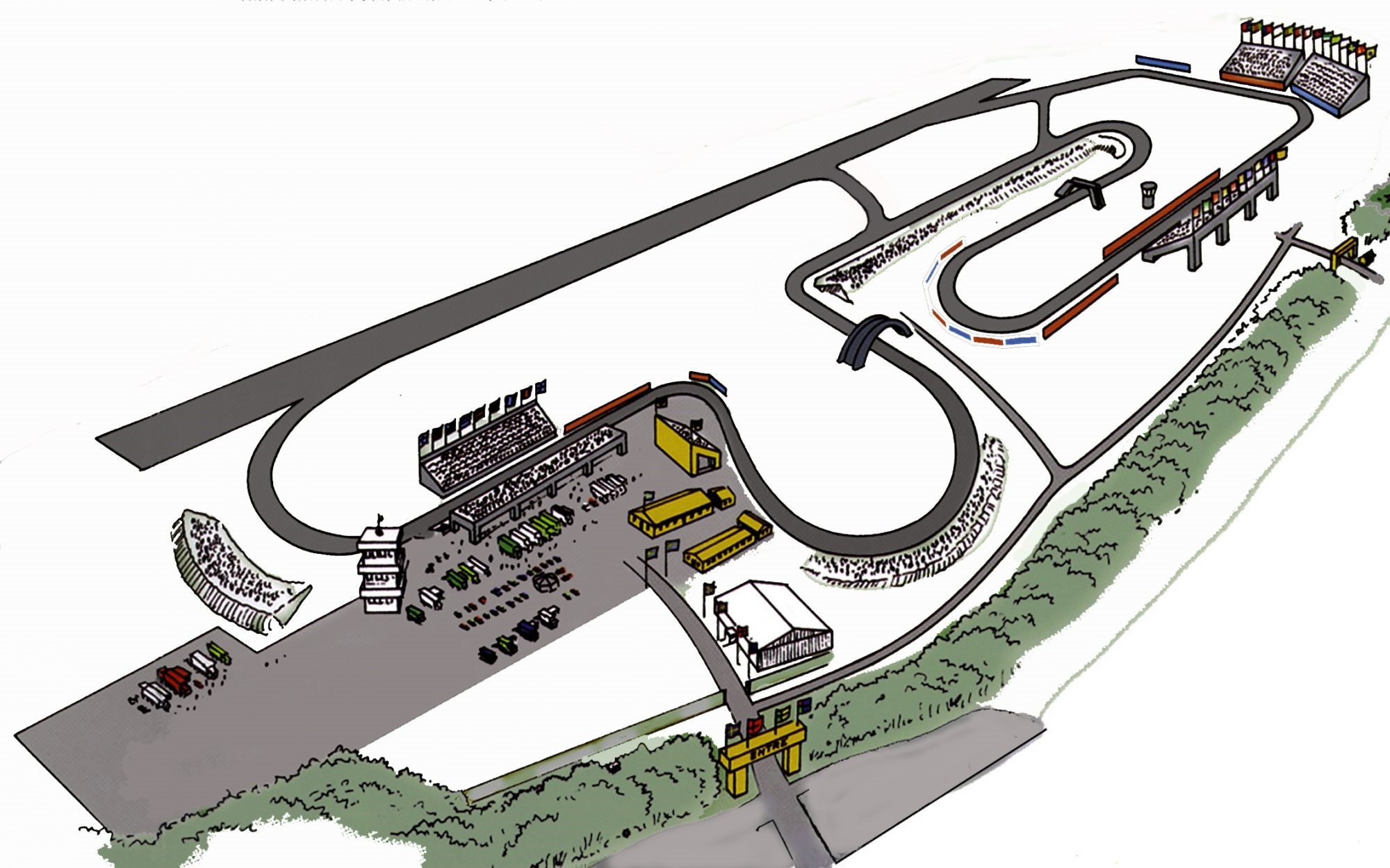
Scandinavian Raceway, Anderstorp.
Track record: EuroBOSS competition in August 2009. Marijn van Kalmthout, Benetton Judd 4.0 V10 (Formula 1 car). Time: 1:21,525, average of 177,737 km/h.

Ronnie Peterson and Bosse Holmström (SVT) in Anderstorp 1974. Posted on 17 September, 2017.
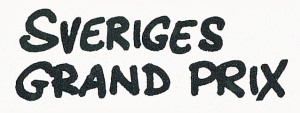

Ronnie Peterson, coveted photo object. Anderstorp, June 1974.

World of Technology 1976.
”What is required to be a good racing driver? A will, an obsession”, Ronnie Peterson said.
No one who followed Ronnie's career had reason to doubt that he had the will to become and to remain the best racing driver in Sweden and in the world and that he was obsessed with that will and that he had the skills required to compete at the top of the world.

Ronnie Peterson Fan Club is said to have been started in 1971 and had Malmö as its base but, at the right of the ad above, you can see that it is to Blomstermåla in Kalmar County, Småland, that letters will be sent. The membership fee in 1974 was apparently 35 Swedish kronor. By the way, there were lots of Ronnie and team stuff to buy at that time, such as decals and pictures.
A web page is entitled "Sweden's Greatest Driving Export: Ronnie Peterson, Legendary Talent." The text is then quite long but the author emphasizes, among other things, that Ronnie is one of the greatest drivers who has not won the title in Formula 1.

Ronnie Peterson and Niki Lauda..
In my old good “Book Dictionary” from 1978 it is said the following: "Peterson Ronnie, born 1944, race car driver, European champion in Formula K in 1966 and in Formula 2 in 1971, second in the World Championship for Formula 1 drivers in 1971 and winner of the World Championship for sports cars in 1972".
Regarding Ronnie's victory in 1971 in Formula 2, the following can be read at the other end of this link: http://www.oldracingcars.com/f2/1971/: ”the championship was won by Ronnie Peterson in a March 712M but Emerson Fittipaldi was almost as quick in his Lotus 69. François Cévert had speed but not enough reliability from his team Tecno and, to complete the variety, Carlos Reutemann finished second in the championship in his Brabham BT30 and BT36 and would have won a title based on all 25 races”.

Barbro Peterson, Ronnie's wife, arrives at the track - Anderstorp - June 1974.
Ronnie and Barbro Edwardsson (1947-1987) met in 1969. Barbro, who came from a color trader family, worked as a secretary but later that year moved to the United States to work as an au pair in New York. When she returned from the United States, she and Ronnie became a steady couple. Barbro was employed as an official timekeeper at Lotus, when Ronnie started driving for them in 1973. They had a daughter named Nina Louise. The Peterson family lived in London but also acquired an apartment in Monaco, where they became neighbors with Björn Borg.
The tragedy occurred in 1978 when Ronnie died after a violent crash at the Monza circuit in Italy, Barbro became a young widow and Nina became fatherless. Barbro later had a relationship for four or five years with John Watson, also a racing driver, but she never managed to get over the grief after Ronnie. She was found dead in her home in December 1987. Nina now became completely orphaned and Watson made sure that she could move back home to her grandmother and grandfather, May-Britt and Bengt. When she was to start class 7 in school, she moved to Ronnie's two year younger brother Tommy and then in ninth grade she continued her education at Lundsbergs boarding school. Nina is a trained interior designer (in London), married since 2002 to Carl-Johan Kennedy and the couple have three children and live in Stockholm.
Nina is a co-producer of a documentary about her famous father's life. The film is called “Superswede”, which premiered in August 2017, as it was a nickname for Ronnie. Both Ronnie and Barbro and also his parents are buried in Almby cemetery in southeast Örebro.

Bosse Holmström interviews Ronnie for “Rapport – Anderstorp” - June 1974.

Ronnie Peterson began his career with a home-built tractor and continued with one of dad Bengt's equally home-built go-carts and won with it, among other things, three Swedish Championship golds, a European Championship gold and a World Cup bronze. In 1966, the elevator fitter Ronnie received a Formula 3 license at Gelleråsen in Karlskoga and Reine Wisell (born 1941) had been a teacher. The car was a home-built one, a Brabham copy that dad Bengt and Sven "Bergvägg" Andersson screwed together.
In 1969, Ronnie found a good sponsor and was able to devote himself full-time to racing and also hire a mechanic. In 1970, he made his Formula One debut at the Monaco Grand Prix and finished in seventh place. He became the second Swede after Joakim Bonnier (1930-1972) to start in a F1 race and made a total of nine starts during the year.

In 1973 Ronnie won his first Formula 1 race on the Paul Ricard track in France and later in the year there were also victories in Austria, Italy and the USA. The following year, 1974, he was able to win in Monaco, France and Italy (but not in Anderstorp in Sweden) and in 1976 on the Monza track. In 1978, Ronnie won in South Africa and Austria, but then came the fateful competition on September 10 on Monza circuit in Italy, when he was seriously injured and lost his life a few hours after an operation the day after the accident. He died of a fat embolism that occurred during a surgical procedure to repair the numerous bone fractures he had sustained.


Bosse Holmström, TV reporter on SVT. Anderstorp - June 1974.

Anders Åberg, member of the organizing committee for the Texaco Grand Prix of Sweden 1974 at Anderstorp.
Bo Holmström (1938-2017) was a very famous TV reporter during his active years and he is best known for his time at Swedish Television and for his reporting in 1975 from the occupation of the West German embassy in Stockholm.

Bosse Holmström with team. Scandinavian Raceway, Anderstorp - 09 June 1974.

Bosse Holmström, “Rapport” and Jan Svanlund from “TV-sporten.” Anderstorp - June 1974.
Bosse Holmström talks to his colleague and sports journalist Jan Svanlund (1941-2011) on TV sports.

2-door Rolls Royce Mulliner Park Ward. Anderstorp Raceway - June 1974.

Denis ”Denny” Hulme in 1974.
I believe, without knowing for sure, that it was McLaren's team manager Phil Kerr (1934-2015) who transported himself to Anderstorp with the help of the above Rolls Royce Mulliner Park Ward. The journey went via Harwich in England, the ferry to Esbjerg in Denmark and on via ferry from Helsingör to Helsingborg to then Anderstorp in Småland (and the same road on the return journey). - This was what applied the year before, 1973 - and then Ronnie Peterson's competitor Denis Hulme (1936-1992) and the "team supporter" John MacDonald also participated in the trip. I also think it was MacDonald who owned the Rolls. By the way, Denny Hulme won the 1973 race in Anderstorp, so it was a successful trip that year for all three in the Rolls.

Denis "Danny" Hulme in 1973, taken from the program sheet for the Texaco 1974 Grand Prix in Anderstorp.
There are many indications that the three people mentioned made the same trip in 1974. Who else would have parked a British-registered Rolls Royce in the pits at Scandinavian Raceway, a Rolls that matches the description of the one of 1973?



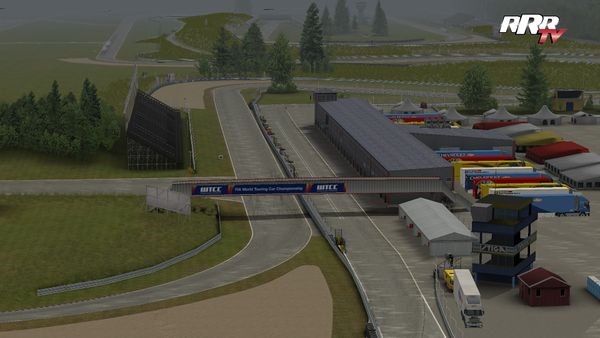



Scandinavian Raceway Anderstorp – Fifty Years of Ups and Downs. June 16, 2018. Marijan Malcevic.

The Scandinavian Raceway, also known as Anderstorp Raceway, is a race track in Sweden that once upon a time was hosting the Formula 1 Swedish Grand Prix.
Besides F1, Anderstorp hosted other major international competitions such as Swedish Motorcycle Grand Prix, Superbike World Championship, European Touring Car Championship, World Touring Car Championship or FIA GT Championship. In recent years, the racetrack hosts national and regional events.
A unique combination of a race track and an airport.
Anderstorp Raceway is located in the town of Anderstorp, in Gislaved Municipality in Jönköping County, about 80 kilometers from Göteborg. Anderstorp Raceway features a combination of the 4.025 km long race circuit and an airport runway which is using a part of the race track, so Anderstorp Airport is not always available due to activity on the race circuit.
An idea of a race track and airport in one facility was born in the summer of 1965 when three local racers, Sven “Smokey” Åsberg, Åke Bengtsson and Bertil Sanell, wanted to have a race track for test rides. The first idea was to build a short 1.5 km track but then they decided to ask local businessmen to help them build a longer track with an airport. An airport would help their isolated town to have a daily connection with Stockholm and will bring prosperity to the local community.

Scandinavian Raceway opened its door in 1968.
The race track was opened in 1968.
In 1966, an idea became a project. Two years later, a project became a race track. The layout of the race circuit was designed by engineer Holger Eriksson, advised by famous Swedish racer Joakim Bonnier.
The original four-kilometer circuit had eight slightly banked curves and a long back straight on which was the airfield runway. Unusually, the pit area was separated from the start/finish line. The pits were between turns five and six.
The Scandinavian Raceway circuit was officially opened on June 16, 1968, with an international sportscar race, won by Jo Bonnier in a Lola T70-Chevrolet.

World-class motorcycle racers came to Anderstorp in 1971.
In the following period, sports car races took place at Anderstorp, then Formula 5000 came in 1970 and, in 1971, the World Motorcycle Championship was the first top-class competition at new Swedish race track. Giacomo Agostini won two races in 500cc and 350cc classes with MV Agusta, later taking world championship titles in both classes.
Swedish Motorcycle Grand Prix took place at Anderstorp seven years in a row, until 1977 and then again from 1981 to 1990. Giacomo Agostini has won one more time in top class (500cc) but the record holders with four 500cc wins are Barry Sheene and Eddie Lawson.

Formula One came to Anderstorp in 1973.

Swedish GP 1973 in Anderstorp. Jean Pierre Beltoise on Brm.

Swedish GP 1973 in Anderstorp. Niki Lauda on Brm.
After some minor modifications were made to the pit lane area in 1972, Sven Åsberg announced that he has a contract for the Formula One Swedish Grand Prix at Anderstorp from 1973.


Ronnie Peterson on Lotus Ford at Swedish GP in Anderstorp on June 17, 1973.
The arrival of Formula 1 coincided with the rise of Swedish ace Ronnie Peterson, who was an F1 vice-champion in 1971 with March and moved to Lotus for the 1973 season.

Swedish GP 1973 in Anderstorp. Francois Cevert on Tyrrell Ford.
Although the circuit is located far from big cities and there were no lot of sleeping facilities, the crowd was big at the inaugural F1 Swedish Grand Prix which took place on June 17, with more than 50,000 spectators around the track.
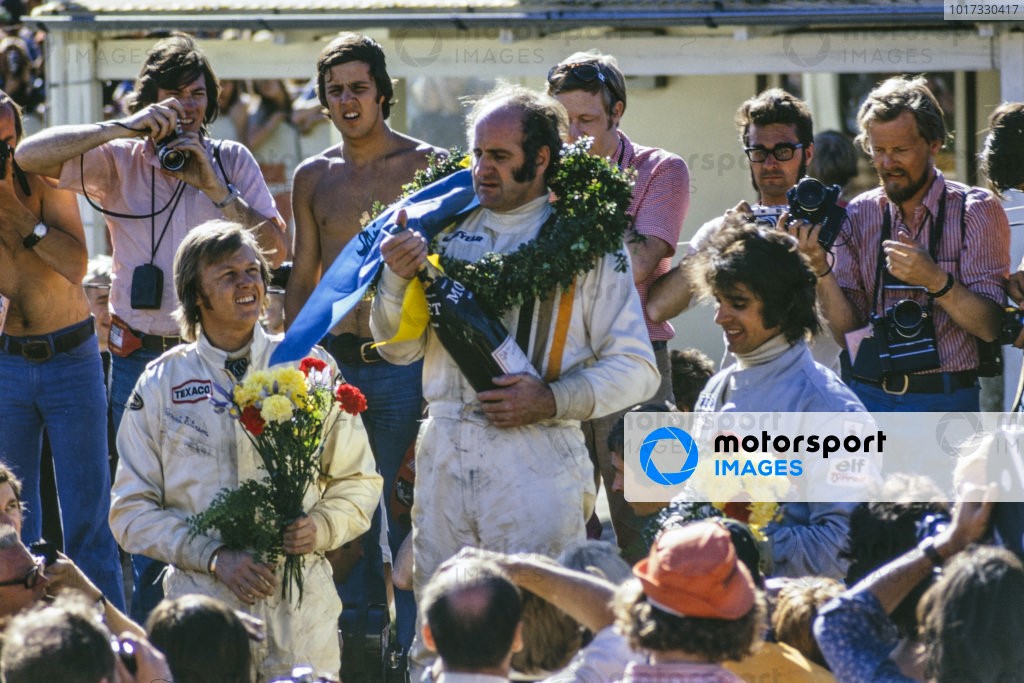
Winner Denny Hulme celebrates victory with Peterson, 2nd position and Francois Cevert 3rd position in 1973.
Ronnie Peterson delighted home fans with pole position (lap time 1.23.810) and led for most of the race, losing a victory on the penultimate lap to Denny Hulme (McLaren). Francois Cevert (Tyrrell) completed a podium.


Jody Scheckter won the 1974 Swedish Grand Prix in the #3 Tyrrell.

Scheckter leads Depailler in a double for Tyrrell at the 1974 Swedish Grand Prix. Photo: Reproduction.
Maiden F1 victory for future champion Jody Scheckter.
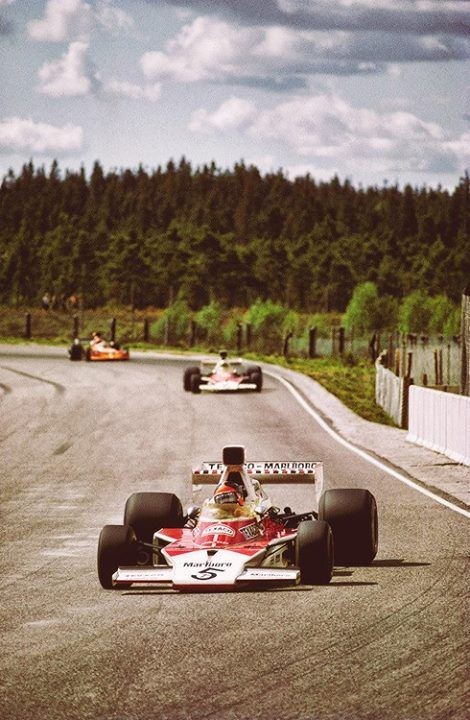
Anderstorp GP 1974.

Niki Lauda at Anderstorp in 1974.
In 1974, Tyrrell’s drivers dominated at Anderstorp. Patrick Depailler was the fastest qualifier in the #4 Tyrrell 007-Cosworth but he finished second behind his teammate Jody Scheckter in the #3 car.

Patrick Depailler and Jody Scheckter, Anderstorp, 1974.
It was Scheckter’s maiden F1 victory. James Hunt was third in the #24 Hesketh.


Reine Wisell - on March 741 at Anderstorp, Sweden in 1974 - drove this race as replacement for regular driver Hans-Joachim Stuck, who was away at Hockenheim in Germany contesting the fifth round of the Formula Two Championship season.
There were three Swedish drivers in the race – Reine Wisell (March), Ronnie Peterson (Lotus) and Bertil Roos (Shadow), all three retired.



Start of the 1975 Swedish Grand Prix.

The start of 1975 Gran Prix. You can note the absent of a pit lane.

Clay Regazzoni on Ferrari 312T ahead of Ronnie Peterson on Lotus. Anderstorp 1975.

Lauda ahead of opponents at the 1975 Swedish Grand Prix. Photo: Getty Images.


1975 Swedish GP. Niki Lauda leads James Hunt.
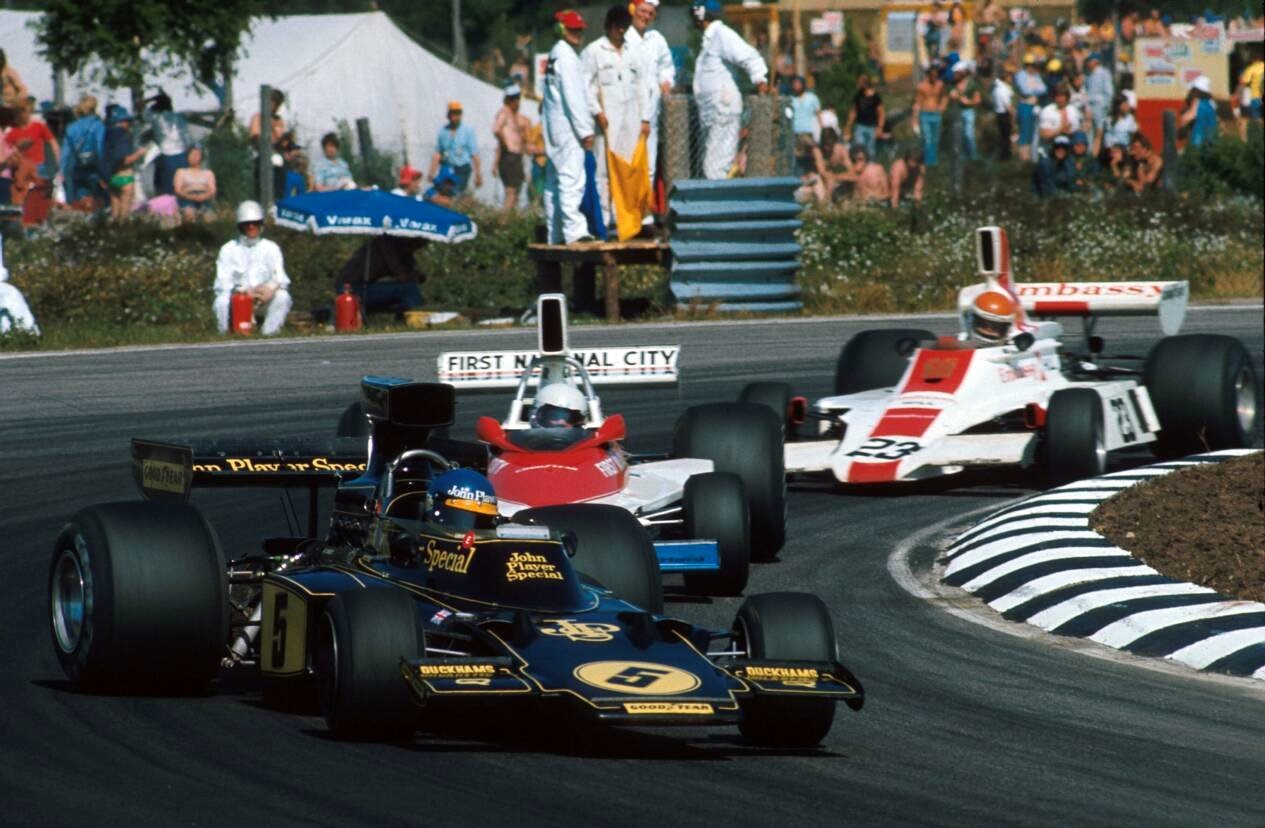
Ronnie Peterson and Mark Donohue at Swedish GP in 1975.

1975 Swedish GP, podium.
Lauda’s victory in 1975 on a way to his first Formula 1 title.
In 1975, Vittorio Brambilla was the fastest qualifier but Niki Lauda won the race in the #12 Ferrari 312T. It was his third win in a row that season. Later in the season, he added two more wins to his account and won his first championship title.

Anderstorp 1975. Clay Regazzoni’s Ferrari 312T.
Carlos Reutemann (Brabham) finished second in the 1975 Swedish Grand Prix, ahead of Clay Regazzoni (Ferrari). Swedish drivers Ronnie Peterson (Lotus) and Torsten Palm (Hesketh) finished ninth and tenth respectively.

Start of Anderstorp Swedish GP in 1976.

Jody Scheckter won at Anderstorp with six-wheeled Tyrrell in 1976. Photo: Getty Images.

Jody Scheckter after his win at 1976 Swedish Grand Prix.
Scheckter’s win in a 6-wheel Tyrrell P34.


Anderstorp 13 June 1976. It was the first and only victory for a six-wheeled Formula 1 car.
At the 1976 Swedish Grand Prix, we saw the second Swedish victory for Jody Scheckter but the race was marked by the first and only victory of a six-wheel F1 car, the Tyrrell P34. Schecker was the fastest qualifier and converted his starting position into a victory, in front of his teammate Patrick Depailler in another P34.

Anderstorp 1976, Ferrari 312 T2.

Anderstorp 1976, Ferrari 312 T2.

Niki Lauda completed a podium in a Ferrari.
Swedish star Ronnie Peterson finished seventh in a March-Cosworth. Another Swedish driver Gunnar Nilsson (Lotus) crashed out early.

French triumph at Anderstorp in 1977.
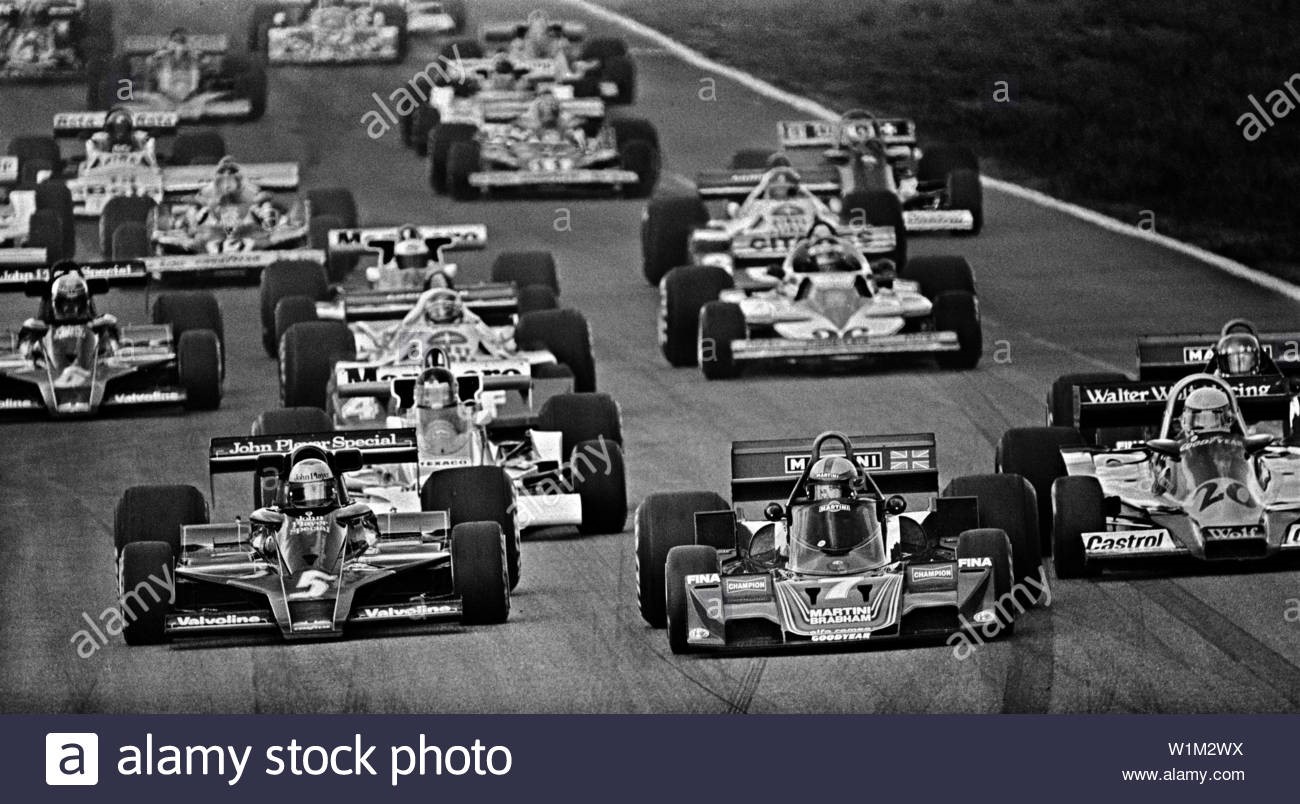
The start of Swedish Grand Prix in Anderstorp 1977.

1977 Swedish GP, Anderstorp.

Jacques Laffite ahead of James Hunt, Patrick Depailler and Jochen Mass at the 1977 Swedish GP. Photo: Reproduction.

The Swedish GP 1977. Andretti had a 15s lead but had to pit for fuel with just 3 laps remaining. Jacques Laffite secured the first win for a French car/driver/team combination in the history of the F1 World Championship.

Podium of the Swedish Grand Prix at Anderstorp in 1977. 1st Jacques Lafitte (Ligier-Matra), 2nd Jochen Mass (McLaren-Ford), 3rd Carlos Reutemann (Ferrari). Grand Prix - Fascination Formula 1.
Jacques Laffite was the winner of the 1977 F1 Swedish Grand Prix in the #26 Ligier-Matra. It was a special victory for France because that was the first time that a French driver won a race in a French car with French engine and backed by a French company. Jochen Mass (McLaren) was second, Carlos Reutemann (Ferrari) completed a podium.


Ronnie Peterson and Gunnar Nilsson, 1977 Anderstorp GP.
Two Swedish drivers Gunnar Nilsson (Lotus) and Ronnie Peterson (Tyrrell) didn’t finish the race.


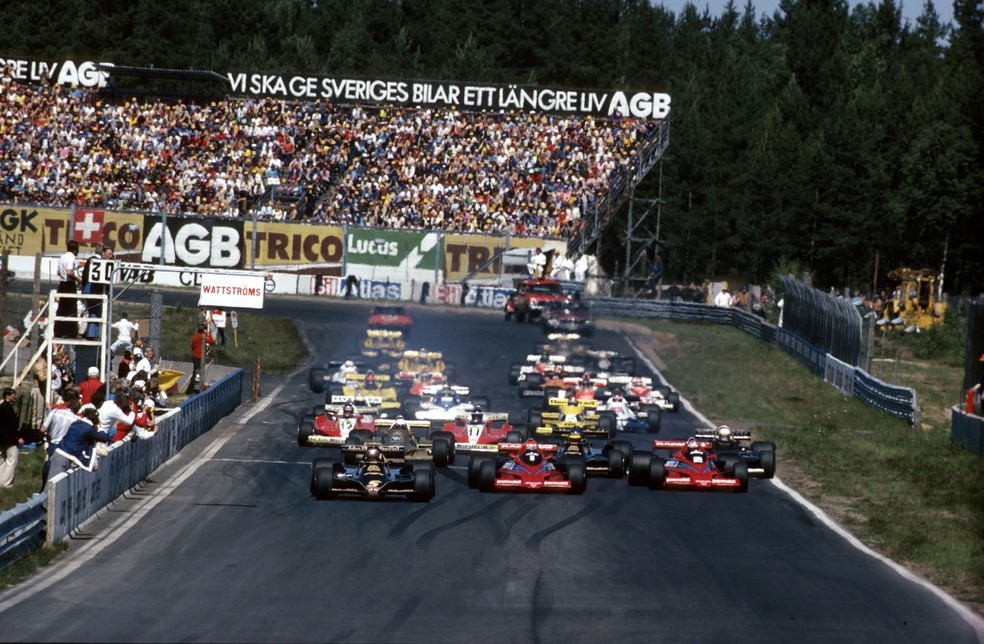

Start of the 1978 GP of Sweden in Anderstorp. Photo Getty Images.

Ronnie Peterson, Anderstorp 1978.
Brabham BT46B ‘fan car’ won the 1978 Swedish Grand Prix.
Two years after a victory of unique Tyrrell’s six-wheeler, another unique and controversial car triumphed at 1978 Swedish Grand Prix. It was the Brabham BT46B-Alfa Romeo, so-called ‘fan car’. The main feature was a large fan which drew air through the engine water radiator which was mounted horizontally over the engine. The fan also took ground effect to a higher level by sucking air from under the car, creating a partial vacuum and an enormous amount of downforce.



June 17, 1978. Niki Lauda wins the Formula One Grand Prix of Anderstorp, Sweden. Shutterstock editorial.
With such a car, Niki Lauda easily won the race. The controversial car never raced again.

Anderstorp, June 1978. Ronnie Peterson with the Royal Couple after his third place. Photo: Expressen.
The podium of the 1978 Swedish Grand Prix was completed by Riccardo Patrese (Arrows) and Ronnie Peterson (Lotus). The Swedish driver reached his second podium in his home race, what turned out to be the last Swedish Grand Prix.

Ronnie Peterson at Anderstorp in 1974.
Death of Ronnie Peterson.
Ronnie Peterson was in a fight for the 1978 championship title, winning two races and scoring five more podiums with Lotus until the unfortunate Italian Grand Prix at Monza in September, in which he was fatally injured. Despite his death, Peterson finished second in the 1978 F1 Championship.
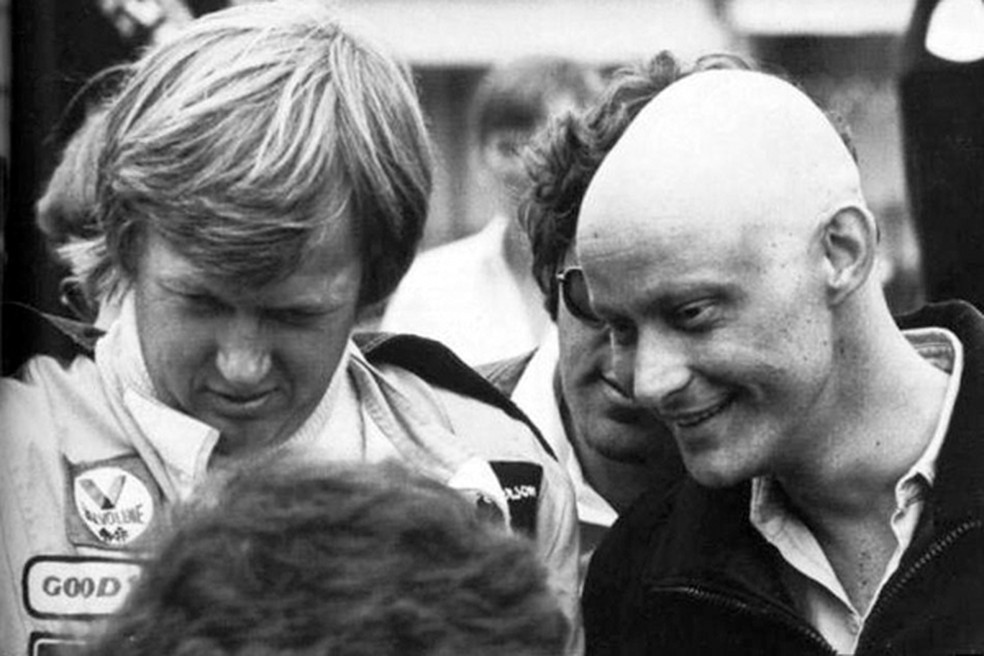
Already without hair because of cancer treatment, Nilsson visited his friend Peterson. Photo: Reproduction.
The death of Swedish racing hero Ronnie Peterson, but also a death of Gunnar Nilsson in October from cancer, decreased an interest for races in Sweden and the Swedish Grand Prix was not a part of the F1 Championship in 1979.
Three years of top-class touring car racing at Anderstorp.
In 1979, Anderstorp had no F1 or Motorcycle Grand Prix, the latter took place in Karlskoga. The Motorcycle Grand Prix returned to Anderstorp in 1981 while the next major championship which came to Anderstorp was the European Touring Car Championship in 1985. Gianfranco Brancatelli and Thomas Lindström, who later took the ETCC title, won a 500km race in a Volvo 240 Turbo.
Volvo won again in 1986 but the team was disqualified after the race, so the victory went to Gianfranco Brancatelli and Armin Hahne in a Rover Vitesse. In 1987, Winfried Vogt and Altfrid Heger won Anderstorp 500 in a BMW M3.
Two Superbike World Championship events at Anderstorp.
In the early 1990s, World Motorcycle Championship left Anderstorp after 1990 but the Superbike World Championship came in 1991. The winner of both races was the American Doug Polen.
The circuit underwent modernization in 1992, including a moving of the start/finish line close to the pits, between turns 5 and 6. Superbikes returned in August 1993, with two wins of Carl Fogarty.
Bankruptcy and a new beginning.
In 1993, the Anderstorp Racing Club went to a bankruptcy caused by problems and financial loss following a 24-hour sports car race. The club overcame problems and reorganized itself as the New Anderstorp Racing Club, continuing to run the Scandinavian Raceway.
In 1994, the major international event was the Interserie sportscar race. In 1995, the Anderstorp 4 Hours became a part of new BPR Global GT Endurance Series. The winners were Michel Ferte and Olivier Thevenin in a Ferrari F40 LM. Next year, Ferrari F40 GTE was a winning car, driven by Anders Olofsson and Luciano Della Noce. In 1998, International Sports Racing Series visited Anderstorp, with a victory of Ferrari 333 SP.
The FIA GT Championship, which had been established in 1997, visited Anderstorp two times, in 2002 and 2003. The winners were Jean-Denis Deletraz/Andrea Piccini in Ferrari 550 Maranello (2002) and Jamie Campbell-Walter/Nathan Kinch in a Lister Storm (2003).

Scandinavian Touring Car Championship at Anderstorp.
Swedish and regional championships as main events.
In the meantime, the Swedish Touring Car Championship has been established in 1996, visiting Anderstorp for the first time in 1997. The inaugural winners were Mattias Ekstrom and Jan Nilsson. In 1999, Anderstorp hosted two STCC rounds, with four wins of Tommy Rustad. There were seven STCC events at Anderstorp between 1997 and 2010. In 2011, the Scandinavian Touring Car Championship was formed and Anderstorp is a regular venue of STCC races since 2015.
In 2007, following a renovation of pit garages in the previous year, Anderstorp hosted the Swedish round of the World Touring Car Championship. Rob Huff won the first race in a Chevrolet Lacetti and then Swedish driver Rickard Rydell triumphed in the second race with the same car. It was just a one-off WTCC appearance at Anderstorp, the World Championship didn’t return to Sweden since then.
The celebration of the 50th anniversary at STCC event.
In the recent years, Anderstorp is hosting Swedish and regional races in different racing disciplines, from single-seaters and sports cars to touring cars. The main event is the round of the Scandinavian Touring Car Championship.
In June 2018, STCC event was an opportunity to celebrate the 50th anniversary of the first race which took place precisely 50th years ago, on June 16. The first ever F1 race at Anderstorp took place on June 17, 1973, while the last Swedish Grand Prix was held on June 17, 1978, so there are two more anniversaries to celebrate.

Map: Anderstorp Raceway layout.
”I stayed at a cowboy hotel in the middle of nowhere.” Published 22 Oct 2018.

From the beginning, it was a peat bog in a pine forest in Småland. – “Here there will be a Formula 1 track”, said the entrepreneur Sven "Smokey" Åberg with a fat cigar in his mouth. Five years later it became a reality. 67,000 spectators cheered Ronnie Peterson and the other stars - who lived and partied in the cowboy town of High Chaparall. SportExpressen has spoken to some of those who participated. This weekend, the US Grand Prix was run at the Circuit of the Americas in Austin, Texas. A beautiful course that costed over three billion Swedish kronor to build.
Speaking of costs: each GP costs the local organizer over SEK 260 million in fees and overheads to the main organization of Formula 1. When the Indian Grand Prix was canceled after three years, the organizers had a debt to the parent company of over SEK 400 million. It was different in Sven "Smokey" Åsberg's time. On the Expressen, the enterprising Småland businessman was once described with the words: "his hair looks like a stubby oat field and he never talks to the same person for more than ten seconds at a time". Eje Elgh met Sven Åsberg several times: - when he said that he would build a Formula 1 track in Anderstorp, not many people thought he would go ashore with it. But he was an entrepreneur without equal, terribly driven. Without "Smokey" it would never have been Formula 1 in Sweden, it was a "one man show", said Elgh, who saw the Formula 1 races in Sweden.

Emerson Fittipaldi and Sven "Smokey" Åsberg laugh with Denny Hulme (winner in 1973). Photo: Jan Holmlund.
The Swedish Grand Prix was run in 1973.
Sven "Smokey" Åsberg ran an industrial company and had a great interest in motoring. The idea for a track in Anderstorp was born when the local motor club needed somewhere to train. Åsberg took aerial photos of the peat bog, then drew the track himself and combined the construction with an airport.
He received support from the municipality and sponsors. In 1973, the Swedish Grand Prix was run. The drivers, accustomed to luxury hotels, were housed in the Wild West Fort High Chaparall. “We lived in a cowboy hotel in the middle of nowhere. There was a gravel road between the track and Chaparall and every day after training we raced to catch up, we drove crosswise, it was like driving a rally, it was very fun”, the then superstar Emerson Fittipaldi told in the film “Superswede”.
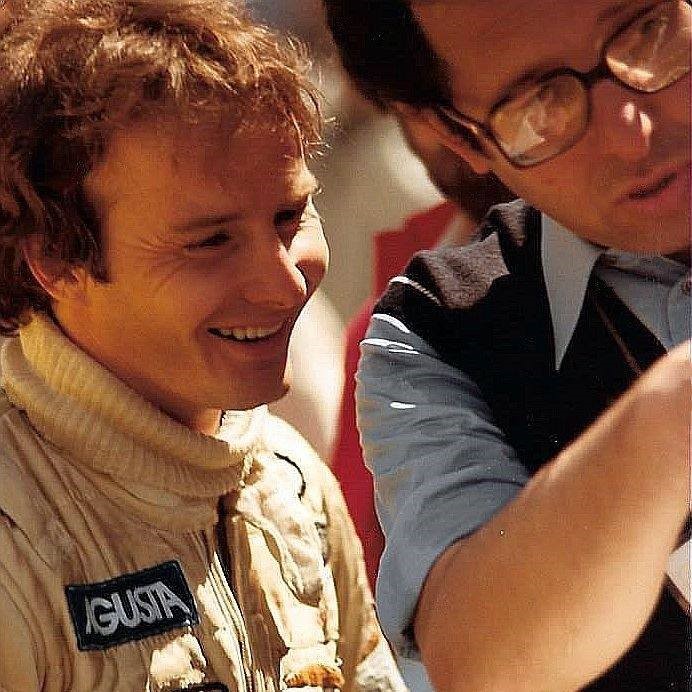
Gilles Villeneuve and Mauro Forghieri.
And, about the road between the track and Chaparall, Mauro Forghieri told of Gilles Villeneuve. "He wanted to go fast. He was always going fast. Doing it gave him a physical pleasure. Anywhere, anyway... I remember him after qualifying at Anderstorp '78. He and I were in the car. To get to the hotel we had to cross a birch forest and he staged a sort of a rally special stage: always counter-steering at 180 km/h; I was freaked out while he was smiling..."
600 journalists from 28 countries reported from Anderstorp.

Before, it was a solitary peat bog. In 1973, it had been transformed into a Swedish Formula 1 track. Photo: Kjell Johansson / Scandinavian Raceway.
Ronnie Peterson came second in the first race, his best result at Anderstorp and he was of course the big draw. But he was accompanied by more compatriots over the years: Gunnar Nilsson, Reine Wisell, Bertil Roos, Torsten Palm and Conny Andersson also took part in competitions.

James Hunt.
Torsten Palm arrived in 1975 and remembers that it went wild even off the track: “among the drivers it was like two camps, the caring ones at the top and then the other gang. There were many who partied too much. Like James Hunt, he could drive fast too, but partied incredibly much”, says Torsten.


When Hunt came to Anderstorp, he had fabric marks on his driver's overalls with the text "sex is a high performance thing" and "happiness is a tight pussy".

Marlboro flew to Anderstorp with 300 guests.

“Expressen” reported on the nightlife and that "even the wild gang of Alexandra Stockholm was there".

“Alexandra or Alexandra's” was Sweden's first modern nightclub. It was run in four different premises in Stockholm by Alexandra Charles in the years 1968–1988. The restaurant and disco club were (almost throughout) open all nights and housed in one of the rooms after another.

Belgian fans show their flag with “we’re just here for the Swedish girls” written on to Swedish fans on the beach in Nice.
The model for Alexandra's was the new nightclubs that were started in London. Alexandra's quickly became a popular place in Stockholm and held that position for twenty years.

Cigarette manufacturer Marlboro made a major investment and flew 300 guests to Anderstrop. Throughout the weekend, full-time "hostesses" walked around handing out cigarettes. It was glamorous and life-threatening. “It was great for me to drive in Formula 1, but when I saw the movie about Ronnie I thought: "how the hell did I dare to go that kind of shit". The safety around the tracks was not at all like today and, when the cars were refueled, the petrol was poured into a funnel. “The fire risk was enormous then and even in accidents”, says Torsten who, after his only completed Formula 1 race, got out of the car at Anderstorp and said: “never again. Why? I thought: I'd rather be a poor car dealer than a dead racing driver. It was the danger that made me quit”. In connection with the first race at Anderstorp, Ronnie Peterson's future wife Barbro was asked by Expressen if she was afraid: “of course I'm scared sometimes. It would be abnormal otherwise”, she said.

Ronnie Peterson with his wife Barbro. Photo IBL.
Ronnie Peterson had then competed abroad for several years and did not know how the audience would respond to him, but there was hysteria when the audience shouted "Ronnie, Ronnie, Ronnie" and he fell in love. Ronnie got love from everyone, even the speaker on the track who, during the race, when Ronnie was going to run over Clay Regazzoni, shouted in the speakers:
“Move man! Move”. In his own column in the Expressen, Ronnie wrote: “the audience was wonderful. I have probably been unsure of what people think of me at home in Sweden. I'm not anymore”. But he himself did not see the races in Sweden as more important than others. No, he was not like that. He wanted to win every competition. He was not so talkative and he could be grumpy when it did not go his way. “His thing was to drive a race car, that was the only thing that mattered”, says Eje Elgh, who was a close friend of Ronnie.
Ronnie led the first race at Anderstorp for over 70 laps before a puncture destroyed his GP and he was overtaken by the winner Denis Hulme. “I would have won if I had avoided the annoying puncture. The air blew out so slowly, with ten laps left”, he said afterwards. The second year, the Swedish king was in the audience and Little Babs was crowned and paid tribute to the winner Niki Lauda. Expressen described life around the competitions: "the women are the same - expensive women, cheap women, the drivers' wives, fiancées or playmates. They have one thing in common - they are all beautiful" - and continued: "racing pits are a thumbs up for jokers, task players and profiteers of the very worst kind". James Hunt was asked what the drivers would do after the race: “we'll get drunk”.
One of the most caring was Ronnie Peterson, but he was unhappy with his car. – “I'm stuck like a fox in a trap at Lotus. I drove the whole race without a brake on the front wheels, I was going off the track several times”, he said after his ninth place in 1975. Then the audience also betrayed, only 31,000 spectators. SVT broadcasted the race and "Smokey" said: "TV stole the audience". He was backed by the municipality and new sponsors until 1976. Then Ronnie Peterson drove a March and Gunnar Nilsson sat in Ronnie's Lotus. Ronnie came seventh, Gunnar did not finish. The winner Jody Schekter won with his six-wheeler and regretted that there was no more audience in the stands. It began to be rumored that Sweden would lose its Formula 1 race. In 1977 there was a bit more audience and in 1978 there was a real upswing, when Ronnie Peterson was back at Lotus and fought for the world title. Then the big snack ice cream became Brabham and their car with a large propeller-like fan at the back.

1978 winner Niki Lauda sprays champagne with Ronnie Peterson and Riccardo Patrese. Photo IMAGO / IBL.
50,000 spectators watched Niki Lauda win with his Brabham. Ronnie Peterson was angry afterwards. Partly with the Italian Riccardo Patrese. “You behaved like a pig, you drove as you usually do in Formula 4. Crosswise off the track and off the asphalt”, the Swede growled. Then he swore over the Brabham car. “Niki Lauda wins the World Cup title in a car that should be banned”.
What no one knew then was that this was Ronnie Peterson's last competition in Sweden. Three months later, he died in Monza. Shortly afterwards, driver colleague Gunnar Nilsson died of cancer.

"Smokey" Åsberg did not want to give up and a seventh Formula 1 race in Sweden was planned in 1979 but, just a month before the race was to be run, "Smokey" was forced to throw in the towel due to lack of sponsors and interest. “Ronnie died, Gunnar carried the coffin and then he also died shortly afterwards - then the plug was really pulled out for Formula 1 in Sweden”, Torsten Palm says. Anderstorp remains, but Formula 1 continues to whiz on completely different tracks. “What was it like driving at Anderstorp? - The circuit was perfectly okay. It was good for overtaking and then it was special with the long flying straight. There we reached 330-340 km/h. Then the pines around the track were close, I can say”, says Torsten Palm.

Anderstorp Racing Club (ARC) was founded in 1966 by Sven Smokey Osberg, Oke Bengtsson and Bertil Sanell. He intended to create a competitive organization for the already planned racing track Scandinavian Raceway. Since the beginning of 1966, hundreds of club members have grown to about 700 during the "boom" of the 1970s for the Anderstorp competition, which was attended by six world championships in Formula 1 and seven world championships in the race track for motorcycles. Since then, the ARC organization is responsible for holding more than 40 major international championships in the world championships, world championships and other world races. Today the club has about 600 members.

The Brabham-Alfa Romeo BT46B ‘fan car’ at the 1978 Swedish Grand Prix.
The 1978 Swedish Grand Prix saw the first and last appearance of the Brabham Alfa Romeo BT 46 'sucker car' which Niki Lauda drove to an easy win.
The 1978 Anderstorp GP was known for 2 reasons: Brabham fan car and the last ever Swedish GP in F1.
The Brabham BT46 raised a storm of controversy; the enormous rear-mounted fan, ostensibly to cool the re-positioned radiators, was thought by rival constructors to constitute an aerodynamic device which contravened the FIA regulation that all such devices be 'firmly fixed while the car is in motion'. It was generally felt that the fan was meant to suck air from under the car, exerting a 'reverse hovercraft' effect of greater downforce.

Niki Lauda won the 1978 Swedish GP with "Brabham fan". Photo: Getty Images.
Following objections the car was banned by the CSI with a promise to make the regulations less ambiguous, but the race result stood.

Alfa Romeo Brabham fan-car in the pits at the Swedish GP in 1978.
The superior traction given the Brabham enabled it to overhaul Mario Andretti's Lotus 79 which had looked unbeatable in its first two races.
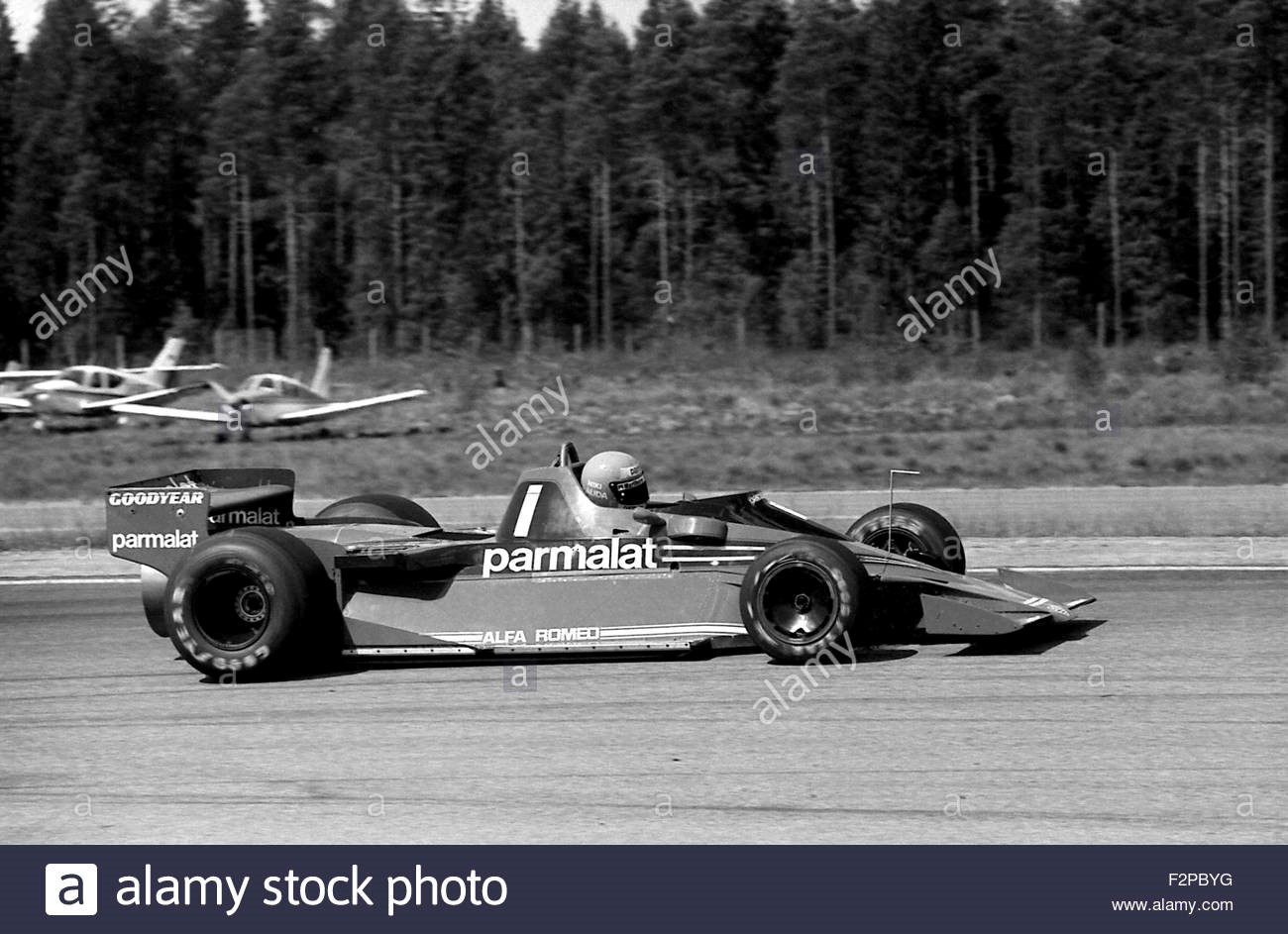
Niki Lauda in an Alfa Romeo Brabham fan-car at the Swedish GP in 1978.
Lauda's win was the first victory for the Brabham-Alfa and briefly raised the prospect of a hard struggle between it and the Lotus to the end of the season.

Brabham-Alfa BT46B Fan Car driven by Niki Lauda at the Swedish GP in 1978.
Andretti's retirement with engine trouble allowed Riccardo Patrese's Arrows second place, fractionally ahead of Ronnie Peterson in the second Lotus who drove a typical, storming race in the later stages.
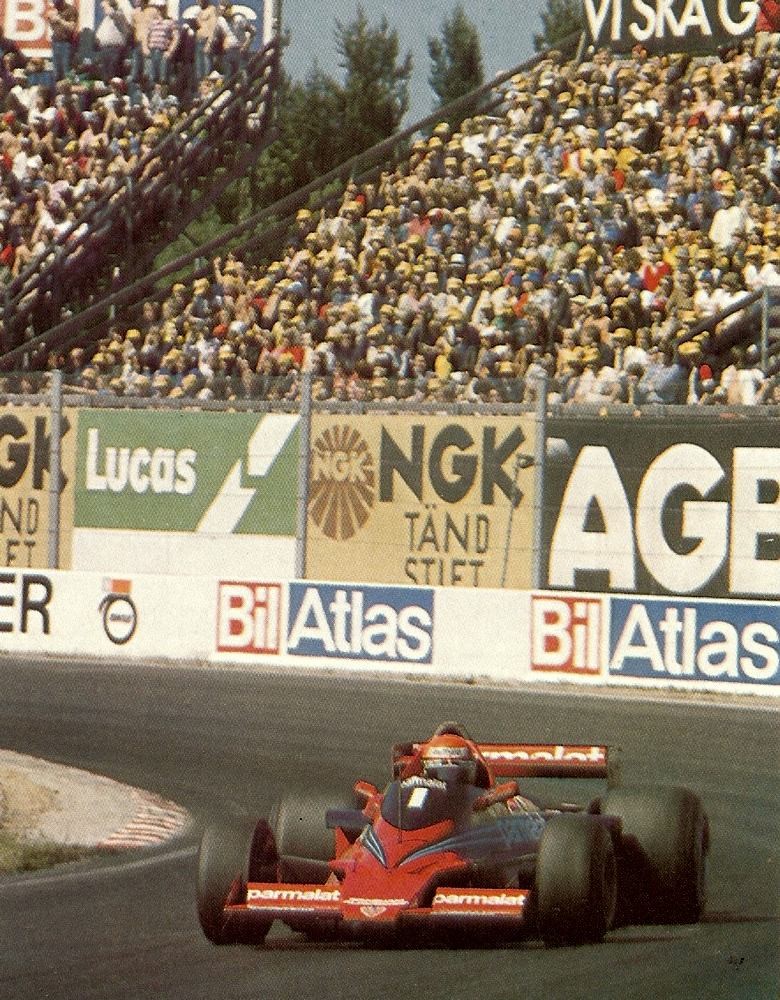
Niki Lauda's Brabham-Alfa BT46 during its first and last appearance in 'fan car' guise, it was an easy winner at the 1978 Swedish GP.
1973 Swedish Grand Prix race report.

Denny Hulme took his frist win of the season driving for McLaren.
A nice clean race.
Anderstorp, Sweden.
There are some people who think that Grand Prix racing should be made more uniform than it is and bemoan the fact that all circuits do not have aircraft landing strips and motels incorporated in their design. Fortunately, Europe is not uniform in everything and each country still possesses some variation, so that although the cast for a Grand Prix does not vary much from race to race, the surroundings still do. With Scandinavia now joining in the Grand Prix circus we had the extremes in contrast by going from the Grand Prix round the streets of Monte Carlo, uphill and downhill between the hotels, houses, shops and restaurants, to the flat, arid waste on which the Swedes have built the Scandinavian Raceway on the edge of the little country town of Anderstorp, though from the circuit there is not a house to be seen, just sandy scrub and distant pine trees. The circuit is absolutely flat, incorporating the Anderstorp airfield runway in the main straight, with the rest of the 4.018-kilometre circuit twisting and turning in a series of uniform right-angle corners and hairpins, with the start and finish and the timekeepers at one end of the wiggly bit and the pits and paddock at the other end. This came about because the CSI inspected the circuit in 1968, when it was built and would not sanction the start line being on the short straight where the pits were, demanding that it should be on the longer straight on the other side of the circuit. By this time the vast tarmac paddock had been laid and the pits built, so the race “control centre” was set up remote from the “nerve centre” and it seemed to work.
The “cast” that journeyed to Sweden by boat, plane and road was little changed from Monaco, except for some non-starters, these being Merzario in the second Ferrari, De Adamich with the third Brabham, Amon with the Tecno, Galli who withdrew from further active participation on the eve of the race and von Opel, there being no sign of the Ensign once again.

Jacques Bernard ‘Jacky’ Ickx, Ferrari 312 B3, 1973 Swedish GP, Anderstorp.
Of the regulars Team Lotus were back to full strength with two cars each for Fittipaldi and Peterson, Ferrari had his two B3 cars for Ickx, Team Tyrrell their three cars 005, 006 and 006/2 with the first number in wedge-nose, side-radiator form, as tried briefly at Zolder, the McLaren team had their three M23 cars for Hulme and Revson, the Ecclestone Brabham team their two BT42 models for Reutemann and Wilson Fittipaldi, with a brand new BT42 in the transporter, though it was not used. The BRM team were reduced to three cars after Beltoise crashed his at Monaco, the line-up being Regazzoni P160/07, Beltoise P160/01 and Lauda P160/08. The UOP-Shadow team had built another new car, for Follmer this time, his Monaco car being reduced to scrap and Team Surtees had the three cars they took to Monaco, the spare car being for Pace. With the loss of Nanni Galli the Williams team had a spare car for Ganley and both cars had been converted to a single front radiator layout instead of the two radiators, one on each side just behind the front wheels, as originally built. The March force comprised Jarier with the works car, Beuttler with the stock-broker’s car, with a new oil radiator layout at the back and Reine WiseII with the car Purley had used at Monaco, it being rebuilt with new body panels and painted bright yellow like the Beuttler car. Graham Hill completed the list with his Shadow, rebuilt and strengthened since Monaco.
Qualifying.

Ronnie Peterson took his fourth pole of the season for Lotus. Motorsport Images.
In total there were four practice sessions and presumably the constructors were being paid sufficient money, for there were no boycotts or complaints of “too much practice” and the practice took place over Friday and Saturday before race day. It was held in early morning and late afternoon on the first day and early morning and lunch-time on the second day, with breaks during each session if any cars became derelict round the circuit and needed collecting and there were quite a number of them. Considering it was all supposed to be practice time the troubles were rather more abundant than was reasonable. The UOP-Shadow team started the ball rolling on Friday morning when Oliver’s Cosworth engine, just back from an expensive Cosworth rebuild, blew up before he even left the pit lane and Follmer crashed his brand new car into the catch fence at the end of the pit straight and crinkled the monocoque, this being DN1/5A. Wilson Fittipaldi barely completed a lap before the engine in his Brabham sheered its oil-pump drive, which ruined the bearings and put him out for the rest of the morning. However, not everyone was in trouble and Cevert was in flying form, sliding round the constant-radius hairpins very prettily and making fastest time, hotly pursued by Peterson, who was naturally the star and hero of his own Grand Prix event, the first to be held in Sweden.
For the second practice Cevert took over the modified Tyrrell and appeared to like it as much as the standard one and improved on his morning time with it, but Peterson was getting into the groove and made fastest time in 72/R6 and second fastest time in his spare car, 72/R8, so that one could say in all truth that he dominated practice, everyone else trying to keep up. Among those who were keeping up well was Reutemann, his Brabham being in fourth place, just behind Cevert’s Tyrrell. Once again Follmer kept the ball rolling, setting off in his Shadow which had been straightened out as best as could be done in the paddock and promptly going off into the sand again, this time without further damage. Oliver and Wilson Fittipaldi joined in now, both with new engines in their cars and Jarier dropped out of the running when the crown-wheel and pinion broke in the Hewland gearbox on his March, while Revson’s McLaren wrecked its gearbox.
On Saturday very few people made much improvement as the circuit seemed to be getting polished and slippery and it had never had such high speeds or hard use before. Trouble and crashes continued unabated, however, Pace bending his Surtees when the left-rear wheel broke off, leaving only the bolted centre on the hub and Regazzoni walked back to the pits when his BRM engine blew up. Beuttler got all crossed up coming into the pit straight and bent the front of his March on the barriers and Fittipaldi had a rear hub carrier break on his spare Lotus. Frank Williams let the Danish F5000 driver Tom Belso have a go in Galli’s Iso-Marlboro and Cevert and Stewart improved their times in the standard Tyrrell cars. Ickx was making steady progress with the lone Ferrari, the spare car not being used, but somehow the small Ferrari effort looked a bit lost and lonely. In the final session Stewart decided to try the modified Tyrrell, in view of the speed Cevert had done with it. So the pedals were all altered so that the little Scot could drive it. After a mere handful of laps he returned to his normal car and the experimental one was put away, there not being time to reset everything back for the long-legged Cevert, so the Frenchman continued in his standard Tyrrell. In the Lotus team there were some minor panics when first Fittipaldi stopped out on the straight in his spare car, the temporarily repaired rear end having given way again and then Peterson was reported to be in trouble in his spare car, but it proved to be merely a shortage of petrol. As practice drew to a close Ganley spun off into the sand and got everything clogged up, necessitating an engine change and general dismantling to get rid of all the sand. Belso had another brief try in the spare Williams car and fewer people still made any improvement to their times, even though they were all flogging round to the bitter end. The timekeepers were using a clever computer to produce results and it was programmed merely to remember and record each cars best lap and to discard any slower ones, so that it threw away all the times that showed no improvement on the “remembered” time, which left us with only the cumulative best time for each driver, along with the cumulative number of laps each driver had completed. Stewart being top of the list with a total of 74 laps in 006/2 Tyrrell, whilst Wisell ran him close with a total of 71 laps. The race distance was to be 80 laps and most drivers managed to complete over half a race during the two days, while Peterson did 32 laps in Lotus R6 and 42 laps in Lotus R8.
Race.

Anderstorp 1973 Swedish Grand Prix. The cars pull away at the start of the race. Motorsport Images.
While the weather had been good during the two days of practice it was really superb on race day and a crowd of 55,000 packed the Raceway, one of the largest crowds at any sporting event ever held in Sweden and Prince Bertil was a keen spectator, honouring the event with his Royal presence. At 9 a.m. on Sunday morning there was a short test session, particularly useful for those teams who had been rebuilding cars or installing new engines, but it produced further troubles, for Ganley had the throttles stick open and crashed IR/01, which he had intended to race and there was a panic to get IR/02 ready, while Fittipaldi had oil leaking out of the rear main bearing seal on his new Cosworth engine, so the back end had to be stripped off and a new seal fitted.
A national Formula Three race and a saloon-car race filled in the morning and then the Grand Prix cars were wheeled out to the pits to prepare for a 1.30 p.m. start. The scheme was that the cars should do warm-up lap and then take up their “dummy-grid” positions in front of the pits and when everyone was ready they would set off in formation round the circuit to the starting line. By 1.50 p.m. nothing had happened for GPDA said there were too many photographers on the edge of the track, the organisers then said they were in a dangerous place anyway and the GPDA (in the shape of President Hulme) said that where the organisers wanted the photographers to go was even more dangerous. Eventually a compromise was reached and the warm-up lap took place, during which Wisell put the brakes on and his hired March broke the left lower front wishbone mounting and he returned to the paddock with the wheel at funny angle. The remaining twenty cars left without him and Peterson in Lotus 72/R6 led them round to the start, where they all paused briefly and were then off with a shattering roar. Eighteen of them got round the first corner, headed by Peterson and Fittipaldi, while Graham Hill got his Shadow on the dirt and the throttle slides got all jammed up. He got going later but was then plagued with electrical troubles. As the nineteen cars roared round the first lap it was the two black and gold Lotus cars leading the two blue Tyrrell cars, followed by Reutemann and Hulme. On the second lap Wilson Fittipaldi got crossed-up at the second hairpin and went off into the rough and wrecked the nose and radiators of his Brabham. Then it all settled down, with lap times two to three seconds slower than in practice, but the leaders going as fast as they could with full petrol tanks and the circuit in race-day condition. Peterson led Fittipaldi by a short distance, while Cevert passed Stewart and led his team leader in pursuit of the Lotus pair, and Hulme passed Reutemann and tailed the two blue Tyrrells. There was nobody else in the race, even though the rest were racing and the order behind the pace-setters was Ickx (Ferrari), Revson (McLaren), Hailwood (Surtees), Beltoise (BRM), Pace (Surtees), Ganley (Williams), Lauda (BRM), Jarier (March), Oliver (Shadow), Follmer (Shadow), Regazzoni (BRM) and Beuttler (March). Apart from Beuttler passing Regazzoni, the BRM having tyre troubles which ruined its handling and Oliver passing Jarier, nothing much happened for a while and they all went round and round.
At 15 laps Beltoise stopped at the pits in response to a signal for his mechanics could see oil leaking from the tank; a rivet holding a baffle had broken, so the hole was bunged-up with a Pop-rivet and the Frenchman was on his way again. Monotony now settled in as the two Lotus cars led the two Tyrrell cars, with the McLaren right behind them, all their Cosworth engines giving equal power and all their Goodyear tyres providing equal grip. Reutemann’s car was vibrating badly and he could not keep up and the two Surtees drivers were very unhappy with their Firestone tyres, while Follmer’s Shadow was handling like a camel, still being a bit out of line after its practice accidents.

Peterson leads Fittipaldi. Motorsport Images.
On lap 33 the monotony was relieved slightly when Stewart felt he had followed his team-mate long enough and went by into third place, this move being prompted by the fact that they were about to lap some of the faster tail-enders and Cevert is not too good in fast traffic. Sure enough Stewart pulled away and began to reduce the gap to the Lotus pair, who were still circulating more or less nose-to-tail. While this was happening Hulme was having a small private drama, for his throttles stuck open and he hastily switched off the ignition, coasting along still in gear; tentatively he switched on again, expecting the engine to fire again on full throttle, but nothing happened! Then he realised the throttles had shut themselves again and pressing the accelerator he found everything was normal, so took up the chase once more, having lost about 15 sec.
Stewart closed up steadily on the Lotus pair and at 41 laps he was right behind them, but there was nothing else he could do and complete stalemate set in as the three cars circulated nose-to-tail, each driver waiting for the others to make a mistake or for some mechanical thing to go wrong. Meanwhile Cevert was dropping back, having lost his inspiration and Hulme was closing up on him pretty rapidly. The rest of the runners were trailing along, being lapped one by one, except for Reutemann, Ickx and Revson.
By 55 laps Hulme was up with Cevert and the leading trio were unchanged, it being difficult to see how it was going to change. Pace had stopped for more tyres and was now lapped. Hailwood had given up the unequal struggle. Oliver retired when his Shadow broke the inner mounting of the lower right rear wishbone, letting the wheel lean in drunkenly and at 58 laps Beltoise pulled off on to the side of the track when his BRM engine blew up.
The leading trio lapped Revson and then it was Cevert’s turn to lap the American’s McLaren and in the scrabble he somehow got held up and HuIme went by both of them, into fourth place! It was a neat bit of team work by the two McLaren drivers, which was more than Cevert could cope with. Ickx was lapped with ease, the Ferrari having been pretty uninspiring all weekend and then Lauda ran low on fuel and had to stop for more, one of his tank breather flap-valves playing up and letting petrol out as well as vapour. He was in a lowly tenth place at the time and a few laps later Ganley also stopped for petrol, losing ninth place, as his mixture control had slackened off and gone to full rich, ruining the consumption.
With eleven laps to go Fittipaldi began to drop back from Peterson as his brakes began to weaken, due to oil from the gearbox getting on the rear discs. This baulked Stewart for a moment, but then he was by and into second place, while Hulme passed the slowing Lotus and took third place on lap 70. On the next lap Fittipaldi had lost all contact with the leaders and continued by using the gearbox to slow the car, but Cevert was catching him fast and took fourth place on lap 73 and on the next lap Reutemann was past the Lotus. Being low on oil and being overstressed when slowing the car the gearbox was beginning to break up and Fittipaldi was struggling desperately to keep going to the finish. Meanwhile his team-mate was in trouble for his left rear tyre was losing pressure and going soft, making it very difficult on right-hand bends, as Fittipaldi suffered in Barcelona.

Sweden, 1973. Winner Hulme lifts Peterson’s arm in a gracious move to indicate the latter’s worthiness as a winner after he finished a close second. Motorsport Images.
Stewart was now doing all he could to get by, but Peterson had his foot hard in and his elbows well out and at 76 laps there was stalemate again, with Peterson desperately racing to the finish, Stewart trying to find a way by and Hulme right behind the pair of them. Fittipaldi’s gearbox finally gave up the ghost and he stopped near the finishing line and then Stewart suddenly slowed right up and Hulme went by. The short links, or straps, that transmit the drive between the left rear brake disc and the gearbox hub had broken up, just as they had done on a front brake at Barcelona. Hulme was now right on Peterson’s tail and the Lotus’ tyre was now really soft and there was nothing the Swede could do to stop the healthy McLaren forcing by on the very last lap. Stewart was passed by Cevert and Reutemann and was very lucky to finish. — D.S.J.
Swedish Swirls.
The UOP-Shadow team took the Team Shambles Trophy away from Team Surtees.
************************************
We wonder if Regazzoni is beginning to think that money isn’t the be-all and end-all of joining a team.
************************************
The Marlboro PR gang really went into action to get Tom Belso into the spare Williams lso-Marlboro. Seems the money was the wrong colour, shape, or size or something as the attempt fizzled out.
************************************
The Tyrrell team may have described Stewart’s trouble as a brake problem, but it looked suspiciously like a design failure.
************************************
Suggestions that Follmer’s next car is going to be built with a “crinkle” in the monocoque are untrue.
************************************
If the professional photographers failed to take any photographs of Hulme winning the race it would be poetic justice after his pre-race belly-aching.
Results: Swedish Grand Prix – Formula One – 80 laps – Scandinavian Raceway, Anderstorp –
4.018 kilometres per lap – 321.44 kilometres — Very warm.
1st: D. Hulme (McLaren M23/1) ….. 1 hr. 56 min. 46.049 sec. – 165.200 k.p.h.
2nd: R. Peterson (Lotus 72/R6) ….. 1 hr. 56 min. 50.088 sec.
3rd: F. Cevert (Tyrrell 006) ….. 1 hr. 57 min. 00.716 sec.
4th: C. Reutemann (Brabham BT42/3) ….. 1 hr. 57 min. 04.117 sec.
5th: J. Stewart (Tyrrell 006/2) ….. 1 hr. 57 min. 12.047 sec.
6th: J. Ickx (Ferrari 312 B3/010) ….. 79 laps
7th: P. Revson (McLaren M23/2) ….. 79 laps
8th: M. Beuttler (March 721G/2) ….. 78 laps
9th: G. Regazzoni (BRM P160/07) ….. 77 laps
10th: C. Pace (Surtees TS14A/03) ….. 77 laps
11th: H. Ganley (Williams IR-02) ….. 77 laps
12th: E. Fittipaldi (Lotus 72/R7) ….. 76 laps – not running at finish
13th: N. Lauda (BRM P160/08) ….. 75 laps
14th: G. Follmer (Shadow DN1/5A) ….. 74 laps
Fastest lap: D. Hulme (McLaren M23/1) in 1 min. 26.146 sec. – 165.2 k.p.h. (new record).
Retirements: R. Wisell (March 731/1), on warm-lap, collapsed front suspension; W. Fittipaldi (Brabham BT42/2), on lap 2, went off road; G. Hill (ShadowDN1/3A), on lap 18, electrical trouble; J-P. Jarier (March 721G/2), on lap 38, broken accelerator cable; M. Hailwood (Surtees TS14A/04), on lap 42, tyre troubles; J. Oliver (Shadow DN1/04A), on lap 52, collapsed rear suspension; J-P. Beltoise (BRM P160/01), on lap 58, engine broke; E. Fittipaldi (Lotus 72/R7), on lap 77, broken gearbox.
21 starters – 14 finishers.

Anderstorp circuit used as the main straight an airstrip for planes. Interestingly, several drivers arrived at the race track during the week of the Swedish GP in their private planes landing on the circuit.
Apart from the straight, the track was basically composed of long radius curves, two of them of 90 degrees and an elbow.
Curiously, apart from the straight for landings and takeoffs, the circuit had no long straights, so the pits were in one part while the start / finish took place on another straight, the second longest on the track.

Anderstorp circuit. Photo: Reproduction / social network.
14 other circuits F1 should – and could – bring back. Nov 14 2020. Jack Benyon.
Six months ago, to mark what should’ve been Dutch Grand Prix weekend, we came up with a dream list of 14 other circuits we thought should – and could – host Formula 1 again.
We were following a ‘Zandvoort rule’ – our picks had to be about as realistic as another F1 race at Zandvoort would’ve seemed before Max Verstappen came along.
Little did we suspect that three of those circuits – the Nurburgring, Imola and Istanbul Park – would all get F1 back before 2020 was over. Another, Sepang, is in the hunt for the vacant Vietnam slot in 2021 too.
Emboldened by that, we’ve had another go at that feature, keeping our original choices that F1 hasn’t gone for just yet and adding a few more that we’d love to see.
Given our success with v1 of this article, we hope you’re looking forward to seeing F1 back at Adelaide and Brands Hatch before too long…



Anderstorp.
Anderstorp. Last hosted F1 in 1978.
Having not hosted top level international motorsport for over a decade, Anderstorp was a slightly unexpected addition to the DTM for 2020 and one that some Formula 1 fans will love the idea of.
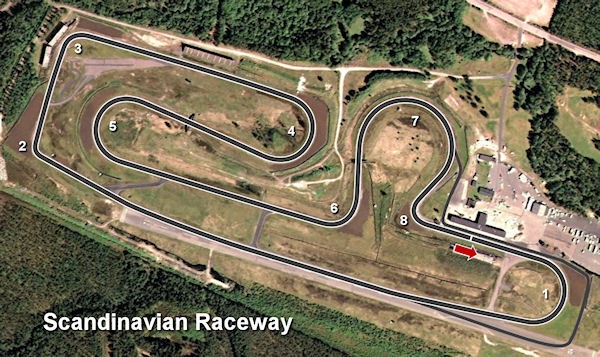
Especially if, like me, you refuse to call it by its new name – the Scandinavian Raceway. Urgh.
Some question how exciting the circuit layout is but it has a nice flow. Its Turn 1 is similar to Mugello, which provided plenty of overtaking earlier this year, while the long horseshoe in the final sector produces differing overtaking opportunities and a long back straight can make for ample passing.

Logistics-wise it’s a three-hour drive to Copenhagen or just under two hours to Gothenburg but it has an airfield for the teams’ and drivers’ fancy private jets.
As for track facilities, the DTM requirements aren’t a million miles away from what F1 needs in terms of infrastructure.
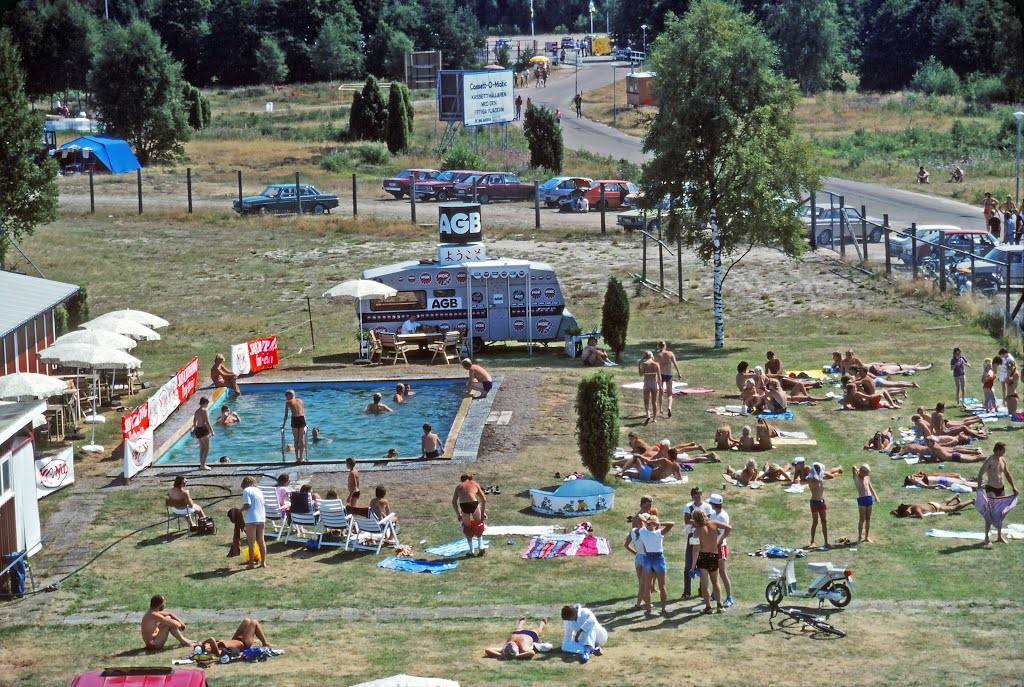
Anderstorp, Scandinavian Raceway, August 1982.
It might not be the place to hold 100,000 spectators right now, but with a bit of investment and another uncertain year ahead, who knows what’s possible?
It would face the challenge of having to upgrade from its FIA Grade 2 status to host F1.
Its biggest problem in recent years has been restrictions on its number of ‘noisy days’ per year. But the current F1 engines shouldn’t be a problem there…
If all of the above hasn’t persuaded you, maybe the fact that Toto Wolff raced a Porsche 911 alongside overall GT track record holder Walter Lechner Jr in 2002 might whet your appetite. He finished 12th overall, third in class in the 500km event, part of the FIA GT Championship. The rest of the teams will be in uproar at Mercedes’ advantage…
Photo gallery

The paddock area of the Scandinavian Raceway, home of the first Swedish Grand Prix at Anderstorp on 17 June 1973. Photo by David Phipps / Sutton Images.

The Lotus 72D of Emerson Fittipaldi in the paddock at Anderstorp, Sweden, on 17 June 1973. Photo by David Phipps / Sutton Images.

The BRM transporter has its load of P160Es unloaded in the paddock at Anderstorp, Sweden, on 17 June 1973. Photo by David Phipps / Sutton Images.

Grand Prix of Sweden, Anderstorp Raceway, 09 June 1974.

Grand Prix of Sweden, Anderstorp Raceway, 09 June 1974.
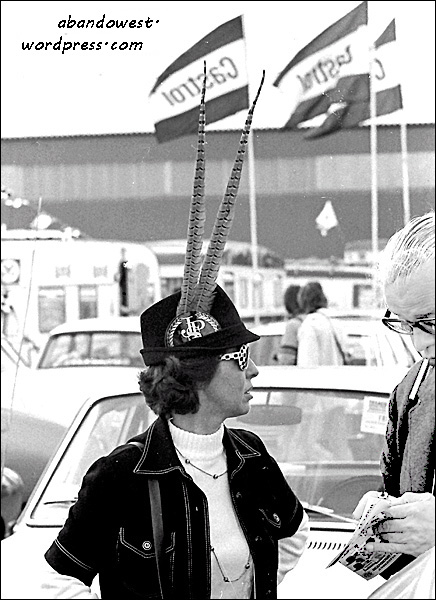
Grand Prix of Sweden, Anderstorp Raceway, 09 June 1974.
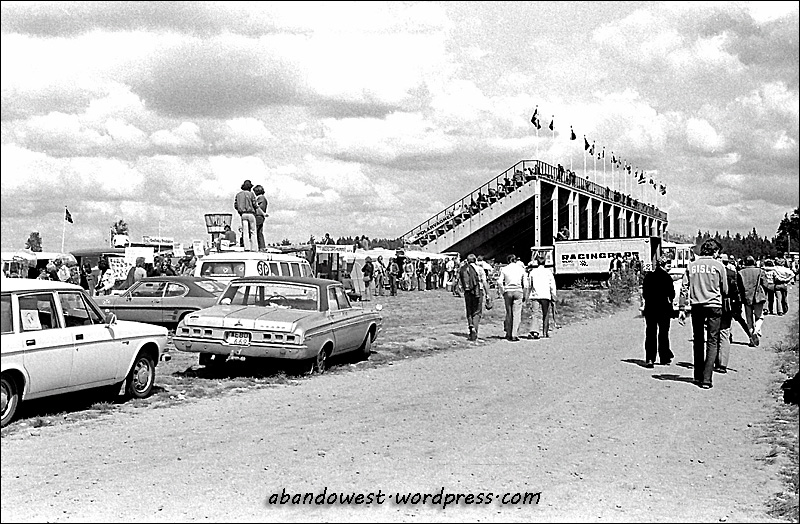
Grand Prix of Sweden, Anderstorp Raceway, 09 June 1974.

Grand Prix of Sweden, Anderstorp Raceway, 09 June 1974.

Some local girls in the paddock at the Swedish Grand Prix in Anderstorp on 09 June 1974. Photo by David Phipps / Sutton Images.

Jody Scheckter has checks made on his Tyrrell 007 in the pits during practice, as Tyrrell designer Derek Gardner (wearing flat cap) and Roger Hill, Tyrrell chief mechanic (headphones, sunglasses), ponder. Scheckter would go on to win the Swedish Grand Prix at Anderstorp on 09 June 1974. Photo by David Phipps / Sutton Images.
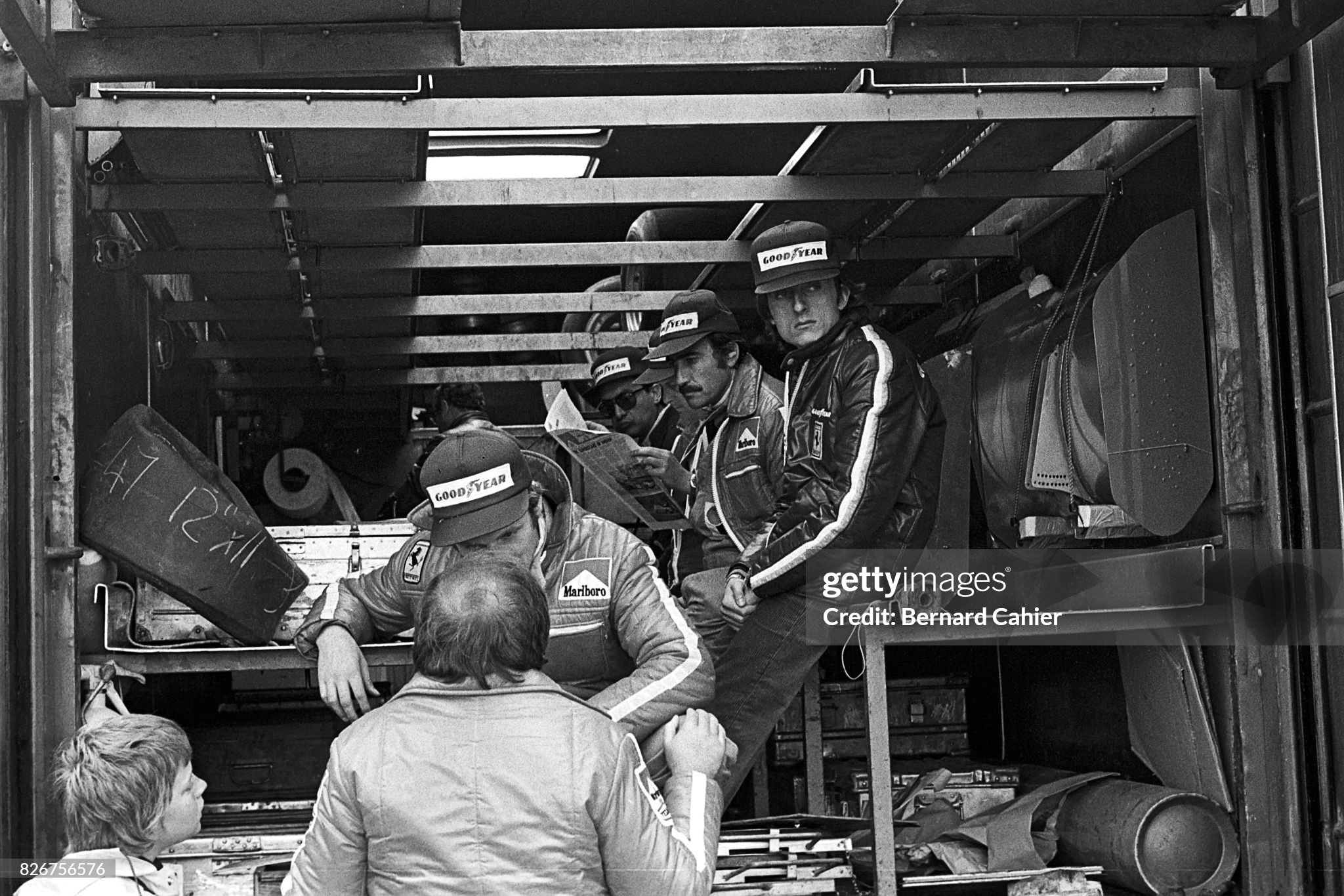
Technical briefing in the back of the Ferrari transporter for Niki Lauda, Clay Regazzoni and Luca di Montezemolo at the Swedish Grand Prix in Anderstorp on 09 June 1974. Photo by Bernard Cahier / Getty Images.
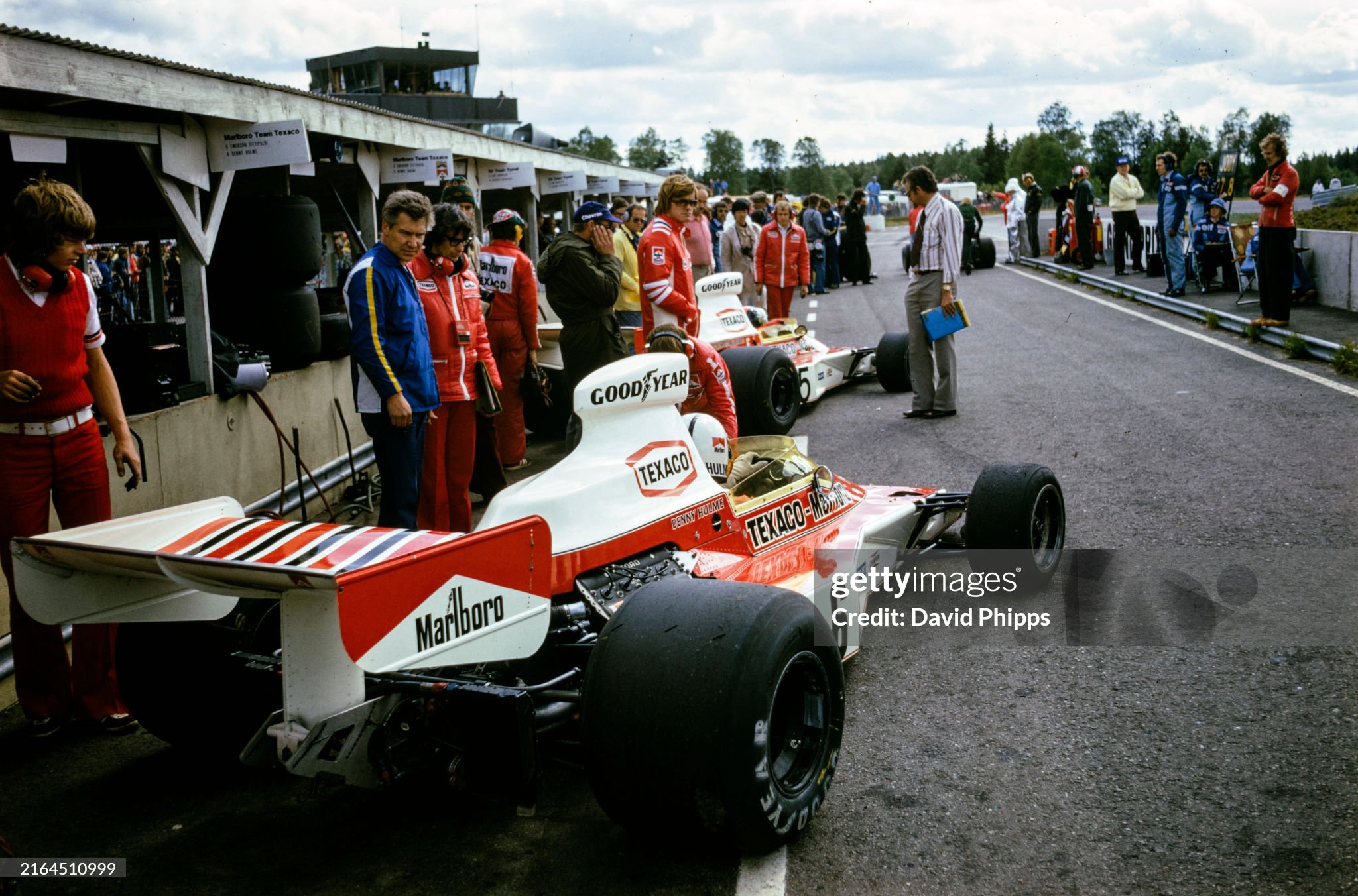
Alastair Cladwell oversees the McLaren M23 Fords of Emerson Fittipaldi and Denny Hulme. Designer Gordon Coppuck is also visible during the Swedish Grand Prix in Anderstorp on 09 June 1974. Photo by David Phipps / Sutton Images.
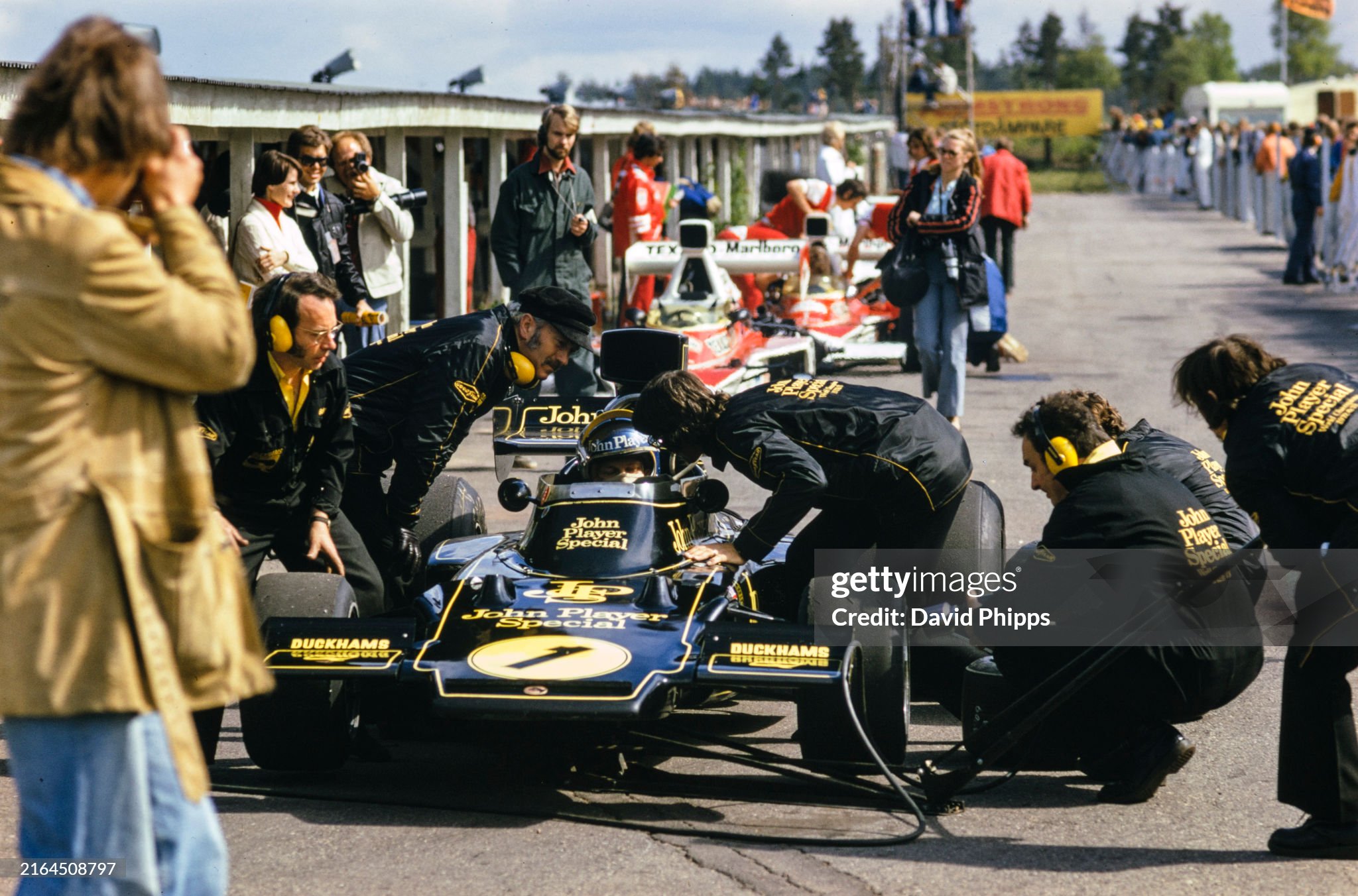
Ronnie Peterson, Lotus 72E Ford, talking to Colin Chapman and Peter Warr in the pits during the Swedish Grand Prix in Anderstorp on 09 June 1974. Photo by David Phipps / Sutton Images.

Niki Lauda, Ferrari 312B3, during the Swedish Grand Prix in Anderstorp on 09 June 1974. Photo by David Phipps / Sutton Images.

Second placed Patrick Depailler holds aloft the hand of first time race winning Tyrrell team mate Jody Scheckter on the podium after the Swedish Grand Prix in Anderstorp on 09 June 1974. Photo by David Phipps / Sutton Images.

Jody Scheckter Tyrrell receives a congratulatory kiss from a Texaco grid girl on the podium after winning his first Grand Prix in Anderstorp on 09 June 1974. Photo by David Phipps / Sutton Images.

The spacious Anderstorp paddock at the Swedish Grand Prix in Anderstorp on 08 June 1975. Photo by David Phipps / Sutton Images.

Vittorio Brambilla during the Swedish Grand Prix in Anderstorp on 08 June 1975. Photo by Ercole Colombo / Studio Colombo / Getty Images.

Vittorio Brambilla, March 751 Ford, during the Swedish Grand Prix in Anderstorp on 08 June 1975. Photo by Ercole Colombo / Studio Colombo / Getty Images.

Clay Regazzoni observes as a mechanic works on his Ferrari 312T during the Swedish Grand Prix in Anderstorp on 08 June 1975. Photo by Ercole Colombo / Studio Colombo / Getty Images.

Mario Andretti's Parnelli VPJ4 Ford during the Swedish Grand Prix in Anderstorp on 08 June 1975. Photo by Ercole Colombo / Studio Colombo / Getty Images.

A front suspension of a Ferrari 312T at the Swedish Grand Prix in Anderstorp on 08 June 1975. Photo by David Phipps / Sutton Images.

Niki Lauda, Ferrari 312T, climbed from a season worst fifth on the grid to take his third victory in succession at the Swedish Grand Prix in Anderstorp on 08 June 1975. Photo by David Phipps / Sutton Images.

Clay Regazzoni, 3rd position, Niki Lauda, 1st position, Carlos Reutemann, 2nd position, on the podium after the Swedish Grand Prix in Anderstorp on 08 June 1975. Photo by Ercole Colombo / Studio Colombo / Getty Images.

Race winner Niki Lauda discusses race set up with Mauro Forghieri and Ferrari team mate Clay Regazzoni, who finished third, after the Swedish Grand Prix in Anderstorp on 08 June 1975. Photo by David Phipps / Sutton Images.

A poster on a door for the Grand Prix of Sweden in Anderstorp on 13 June 1976. Photo by David Phipps / Sutton Images.

An F3 car passes a small aeroplane parked on the runway on the circuit infield at the Grand Prix of Sweden in Anderstorp on 13 June 1976.Photo by David Phipps / Sutton Images.
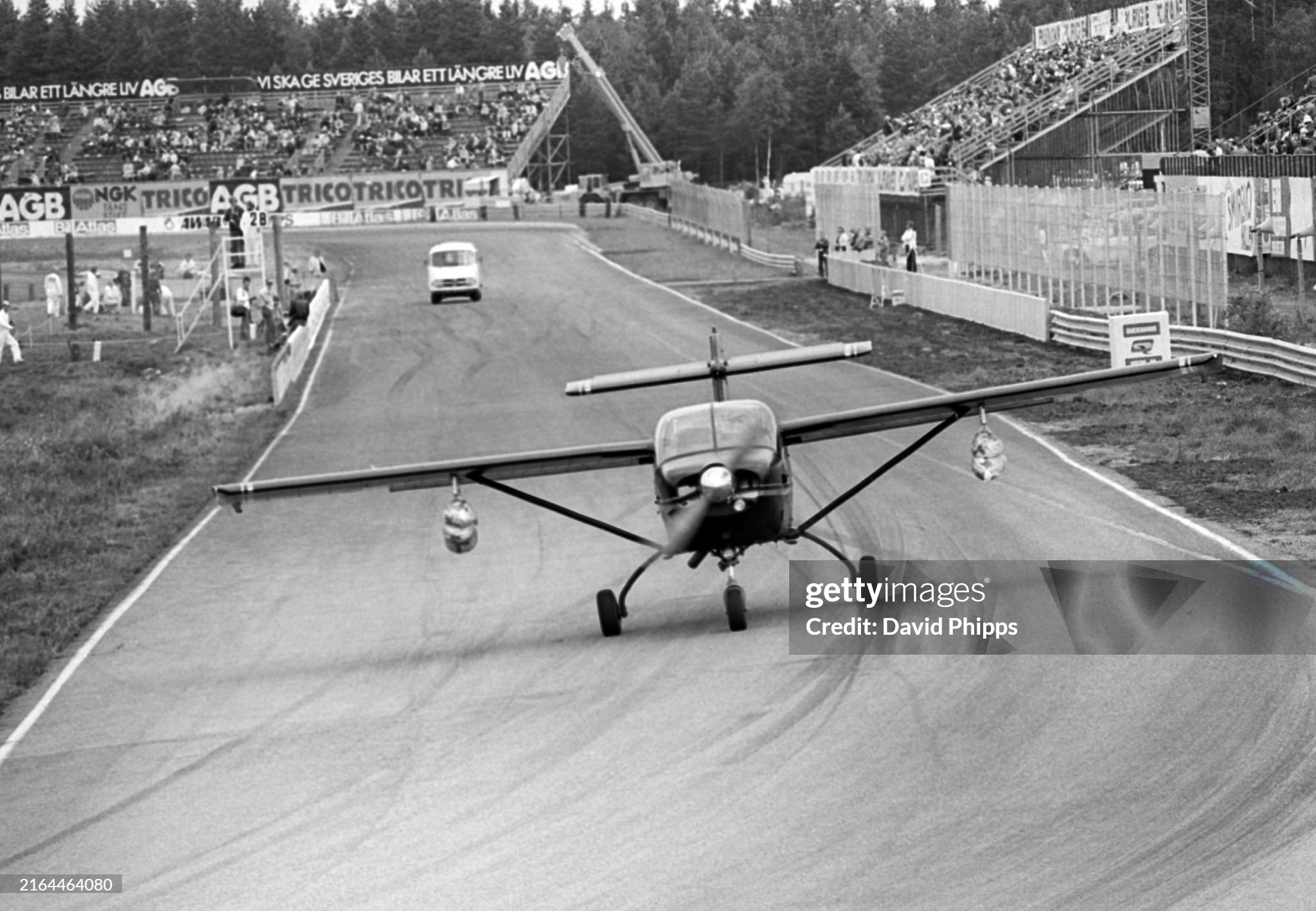
An aeroplane lands on the main straight shortly before the drivers parade at the Grand Prix of Sweden in Anderstorp on 13 June 1976. Photo by David Phipps / Sutton Images.

Jochen Mass on the drivers' parade during the Swedish Grand Prix at Anderstorp Raceway on 13 June 1976. Photo by Ercole Colombo / Studio Colombo / Getty Images.

Pam Rowe (GBR), photographer, at the Grand Prix of Sweden in Anderstorp on 13 June 1976. Photo by David Phipps / Sutton Images.

Pam Rowe (GBR), photographer, at the Grand Prix of Sweden in Anderstorp on 13 June 1976. Photo by David Phipps / Sutton Images.

Fine food and hospitality in the First National City Bank paddock tent at the Grand Prix of Sweden in Anderstorp on 13 June 1976. Photo by David Phipps / Sutton Images.
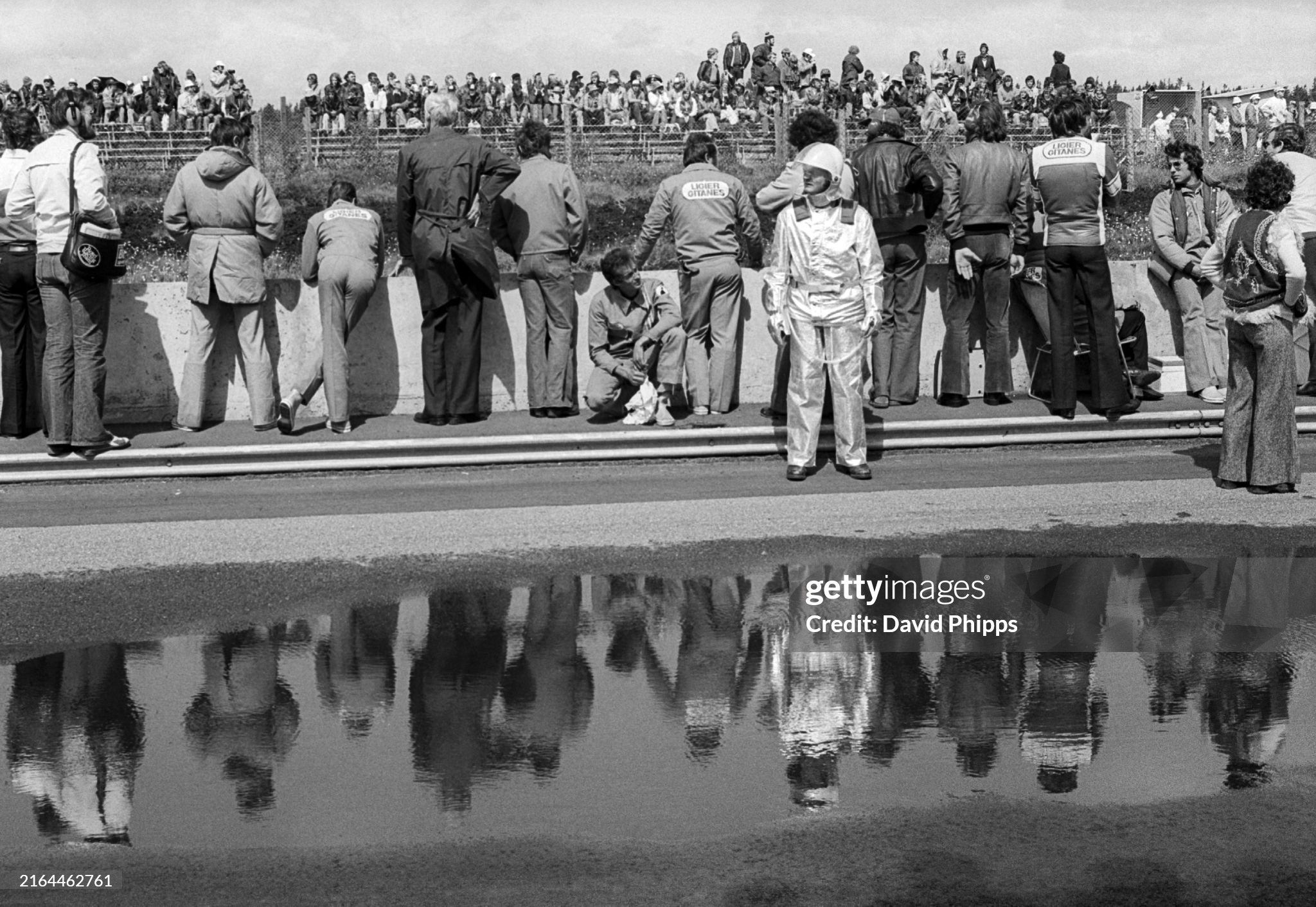
Those on the pit wall are reflected in a puddle in the pit lane during the Grand Prix of Sweden in Anderstorp on 13 June 1976. Photo by David Phipps / Sutton Images.
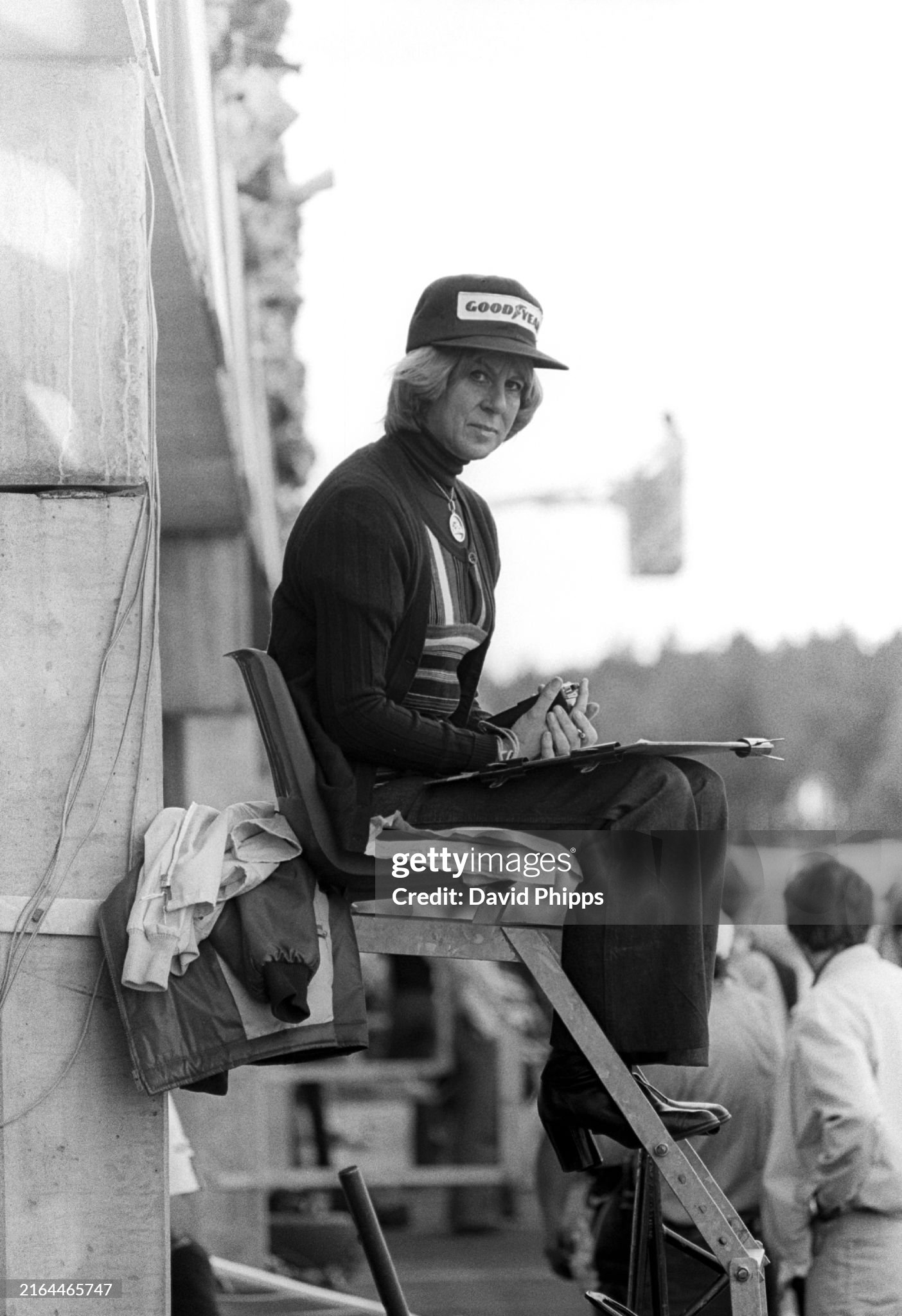
Norah Tyrrell (GBR), wife of Ken Tyrrell (GBR), Tyrrell Team Owner, takes lap times during practice in the pits at the Grand Prix of Sweden in Anderstorp on 13 June 1976. Photo by David Phipps / Sutton Images.

A Brabham mechanic in the paddock unpacks from the freight an Alfa Romeo flat 12 engine that powered the BT45 at the Grand Prix of Sweden in Anderstorp on 13 June 1976. Photo by David Phipps / Sutton Images.

A Marlboro pit stop competition takes place on the pit straight at the Grand Prix of Sweden in Anderstorp on 13 June 1976. Photo by David Phipps / Sutton Images.

Penske mechanics practice tyre changing pit stops on the PC4 of John Watson, who would crash out on the opening lap of the race when his throttle stuck open, at the Grand Prix of Sweden in Anderstorp on 13 June 1976. Photo by David Phipps / Sutton Images.

Photographers shoot from the bridge as race winner Jody Scheckter (RSA) Tyrrell P34 enters the distinctive pit lane during practice for the Grand Prix of Sweden in Anderstorp on 13 June 1976. Photo by David Phipps / Sutton Images.

Competitors head under the Gislaved bridge on the circuit. Tyre company Gislaved were the race sponsors at the Grand Prix of Sweden in Anderstorp on 13 June 1976. Photo by David Phipps / Sutton Images.

Twelfth placed Jean-Pierre Jarier, Shadow DN5B, leads his team mate, ninth placed Tom Pryce, as a yellow flag is waved by a marshal from his gantry at the Grand Prix of Sweden in Anderstorp on 13 June 1976. Photo by David Phipps / Sutton Images.

The Lotus 77 of Gunnar Nilsson is removed from the circuit and onto a truck in the pit lane after he crashed out on lap 3 of his home Grand Prix at Anderstorp on 13 June 1976. Photo by David Phipps / Sutton Images.

Race winner Jody Scheckter, Tyrrell, celebrates on the podium as his team mate Patrick Depailler takes his spot in second position at Anderstorp on 13 June 1976. Photo by David Phipps / Sutton Images.

The podium of the Grand Prix of Sweden in Anderstorp on 13 June 1976: Patrick Depailler, Tyrrell, second; Jody Scheckter, Tyrrell, race winner; Niki Lauda, Ferrari, third. Photo by David Phipps / Sutton Images.
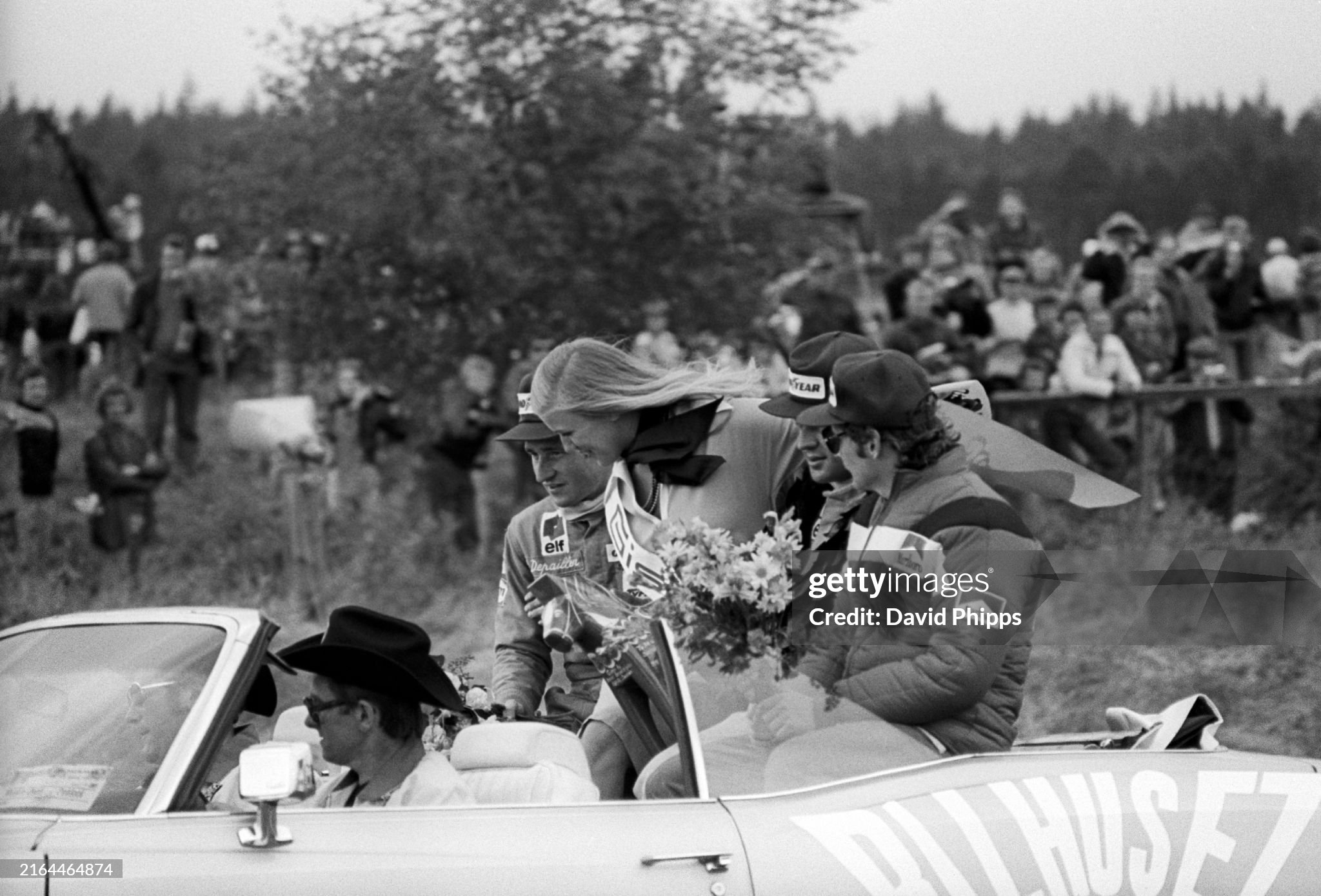
The podium finishers head out on the back of a car for a celebratory lap of the Anderstorp circuit on 13 June 1976. Photo by David Phipps / Sutton Images.

The damaged Emerson Fittipaldi Fittipaldi F5 Ford, tangled in catch fencing, is guarded by team members during a practice session of the Swedish Grand Prix at Anderstorp Raceway on June 19 1977. Photo by David Phipps / Sutton Images.

Williams pits during the Swedish Grand Prix at Anderstorp Raceway on 19 June 1977. Photo by Ercole Colombo / Studio Colombo / Getty Images.

An engine during the Swedish Grand Prix at Anderstorp Raceway on June 19 1977. Photo by David Phipps / Sutton Images.

David Purley, LEC CRP1, during the Swedish Grand Prix at Anderstorp Raceway on June 19 1977. Photo by David Phipps / Sutton Images.
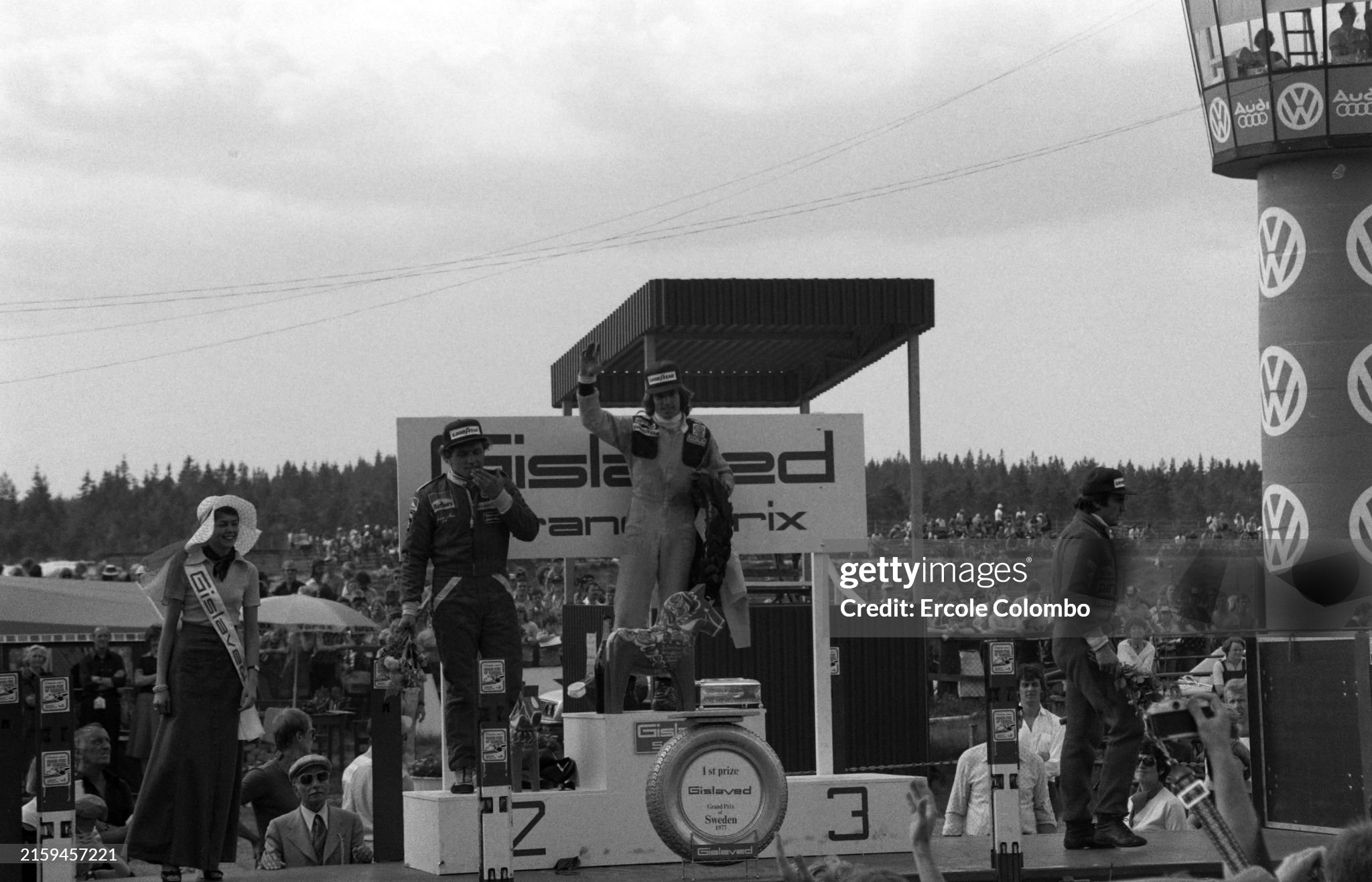
Jacques Laffite, 1st position, Jochen Mass, 2nd position and Carlos Reutemann, 3rd position, on the podium after the Swedish Grand Prix at Anderstorp Raceway on 19 June 1977. Photo by Ercole Colombo / Studio Colombo / Getty Images.

Jacques Laffite, Ligier, celebrates his and the team's first Grand Prix victory on the podium after the Swedish Grand Prix at Anderstorp Raceway on June 19 1977. Photo by David Phipps / Sutton Images.

The Ferrari 312T3 cars of Carlos Reutemann and Gilles Villeneuve in the team's transporter during the Swedish Grand Prix at Anderstorp on 17 June 1978. Photo by David Phipps / Sutton Images.

Ferrari's timekeeping equipment, the Heuer developed ACIT system (Automatic Car Identification Technology), during the Swedish Grand Prix at Anderstorp on 17 June 1978. Photo by David Phipps / Sutton Images.
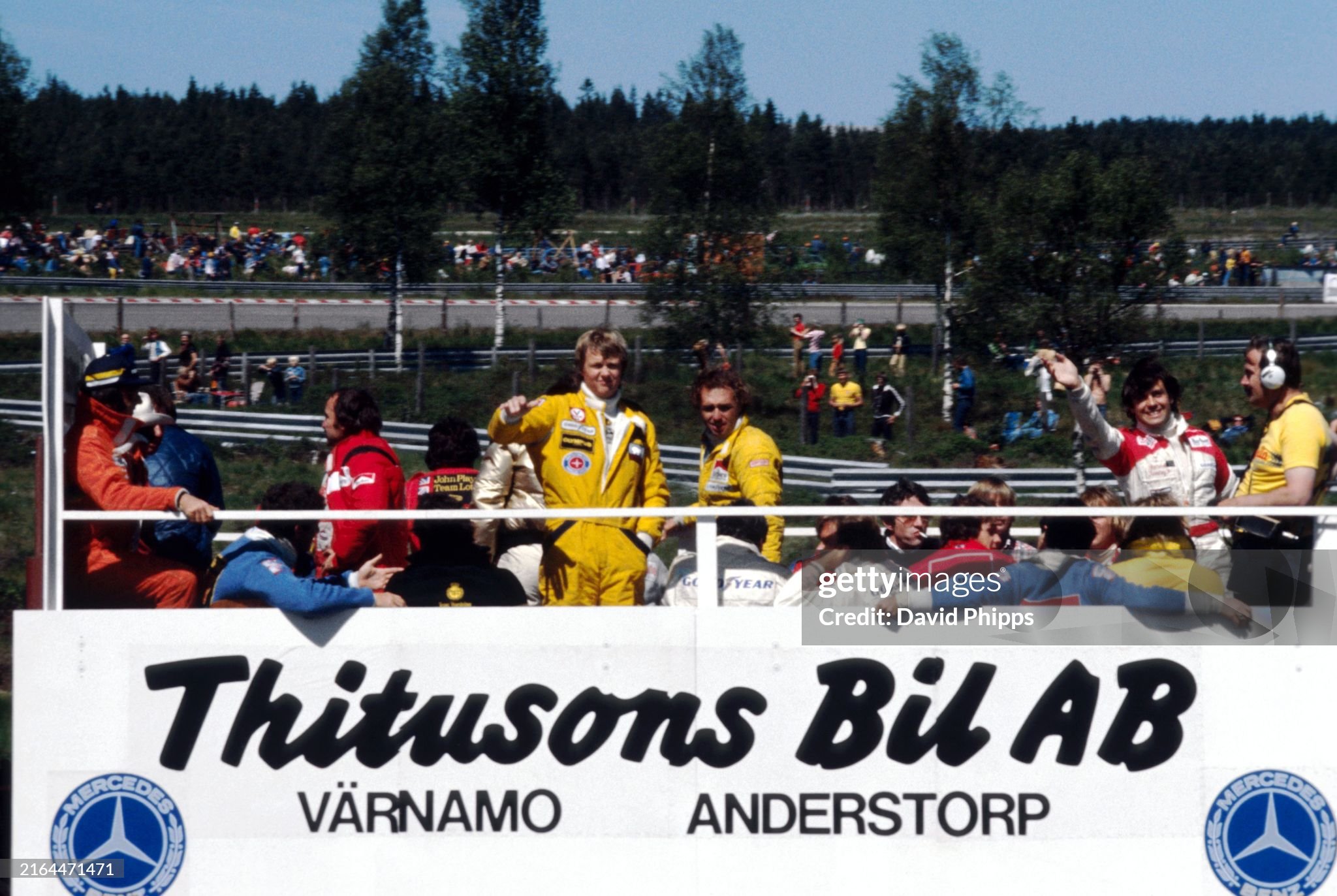
The drivers take part in a pre-race drivers’ parade around the circuit. Local hero Ronnie Peterson, Lotus, waves to the crowd, as does Patrick Tambay, McLaren, before the Swedish Grand Prix at Anderstorp on 17 June 1978. Photo by David Phipps / Sutton Images.

Niki Lauda and James Hunt are amongst a group of drivers lined up during the Swedish Grand Prix at Anderstorp Raceway on 17 June 1978. Photo by Ercole Colombo / Studio Colombo / Getty Images.

Fan efflux at back of Brabham-Alfa BT46B fan car that raced just once in this Swedish Grand Prix at Anderstorp, dropped by team owner Bernie Ecclestone in 1978. Photo by GP Library / Universal Images Group via Getty Images.

The rear end of Niki Lauda's Brabham BT46B Alfa Romeo fan car. After his 1st position in the 1978 Swedish Grand Prix at Anderstorp the car was promptly and controversially banned before the next Grand Prix. Photo by Lat Images.
Videos



Comments
Authorize to comment